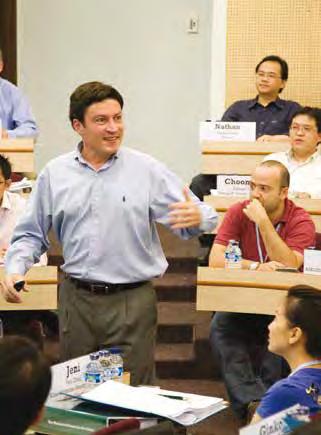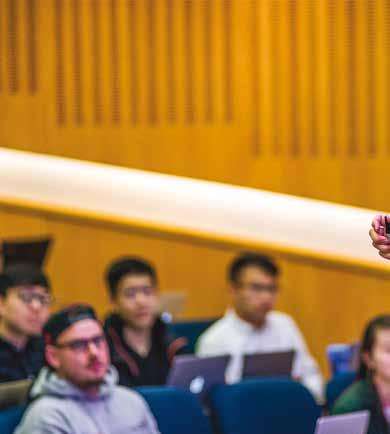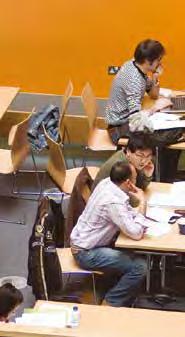One or the other B-school deans must master the art of paradox

Leadership Time we rethought what it is
Odds on Simple risk management is too risky
Education Will it teach you what you should know?
Executives Why we need them on the case
Analytics Think of a (very big) number
EFMD Business Magazine | Iss.3 Vol.11 | www.efmd.org Maintaining the gold standard 20 years of EQUIS success
The
th

















platform

highered@efmdglobal.org
Highered - EFMD Global Career Services connects companies, schools and students at an unprecedented level. Adding diversity, corporate innovation and employer branding possibilities for companies around the world. Providing unique international possibilities for the students and supporting the school’s initiatives in placing students.
e
where we connect top companies with top talent Join the global network of the 500 top schools and over 100 top companies.
EFMD Global Career Services
In focus
Welcome to the October 2017 issue of Global Focus
In our cover story we celebrate 20 years of EQUIS, EFMD’s quality assurance programme, and look forward to the next two decades.
In a detailed and wide-ranging essay (page 6), EFMD stalwarts Michael Osbaldeston and Ulrich Hommel analyse the philosophy underlying the EQUIS system and suggest how it will face up to the challengers of the future.
“From the beginning,” they write, “EQUIS aimed to achieve both recognition of quality and quality improvement in the world’s top business schools – recognition through the award of a quality label that is valued worldwide by students, faculty, employers and the media (having now become a prerequisite for entry into some prestigious rankings) and improvement through the need to meet, and continue to achieve, internationally agreed quality standards.”
In recognising and encouraging improvements in the quality of management education, EQUIS concentrates on 10 areas: strategy, governance, programmes, students, faculty, research, resources , internationalisation, community contribution and corporate engagement.
The relevance if this approach is well illustrated by other articles in this issue which demonstrate how business schools around the world are using tools from this and similar models to navigate in an increasingly complex environment
For example, on page 14 Marianne Lewis suggests new ways deans can cope with the stress of their role, on page 24 Julia Balogun describes how partnerships can help a school build diverse online masters programmes, and Ulrich Hommel and Ben Woods argue that business schools need more than conventional risk management system.
Also in this issue, authors tackle the long standing issue of how to get the most out of case studies, including bringing executives of featured cases into the classroom to debate with students (page 38) and how to create “reality-cases” (page 52).
Finally, on a slightly lighter note Julie Davies and David Buisson (page 48) say that business school anniversaries (and accreditation schemes for that matter) can be more fun – and more enlightening – than you might think.
More ways to read Global Focus
You can read Global Focus in print, online and on the move, in English, Chinese or Spanish
Go to www.globalfocusmagazine.com to access the online library of past issues
Or search iTunes for your iPad edition
Your say
We are always pleased to hear your thoughts on Global Focus, and ideas on what you would like to see in future issues.
Please address comments and ideas to Matthew Wood at EFMD: matthew.wood@efmd.org
1
In focus | Global Focus
Global Focus Iss.3 Vol.11 | 2017
Global Focus
The EFMD Business Magazine Iss.3 Vol.11
Executive Editor
Matthew Wood | matthew.wood@efmd.org
Advisory Board
Eric Cornuel, Howard Thomas, John Peters
Consultant Editor
George Bickerstaffe | georgebickerstaffe@gmail.com
Contributing Editors
Mats Alvesson
Julia Balogun Andreas Biagosch
David Buisson
Julie Davies Caroline D Ditlev-Simonsen
Ulrich Hommel
Marianne Lewis Simon Mercado
Sriven Naidu
Michael Osbaldeston
Julie Perrin Halot Anne Vaxelaire Ben Woods
Design & Art Direction
Jebens Design | www.jebensdesign.co.uk
Photographs & Illustrations
©Jebens Design Ltd / EFMD unless otherwise stated
Editorial & Advertising
Matthew Wood | matthew.wood@efmd.org Telephone: +32 2 629 0810
EFMD aisbl
Rue Gachard 88 – Box 3, 1050 Brussels, Belgium
www.globalfocusmagazine.com www.efmd.org
6
Maintaining the gold standard: building on 20 years of EQUIS success
Ulrich Hommel and Michael Osbaldeston celebrate two decades of EQUIS and look forward to another 20 years of opportunities
14
Paradoxess of business schools
Marianne Lewis argues that deans need to adopt a ‘paradox’ approach towards the tensions involved in leading a business school
20
Developing collaborative leaders
Sriven Naidu describes a new type of collaborative leader required for the complex interdependent systems in a global economy and a resource-constrained world
24
Building a global presence
Julia Balogun outlines how commitment and a successful partnership are helping a UK management school anchor and build its diverse online masters programmes

2 EFMD Global Focus_Iss.3 Vol.11 www.globalfocusmagazine.com
©EFMD 14
Contents
56
28
Creating the resilient business school
Ulrich Hommel and Ben Woods argue that business schools should look beyond conventional risk management systems to the strategic build-up of organisational resilience

32
Does education guarantee knowledge?
It cannot be assumed that education automatically confers learning, qualification and greater wisdom, says Mats Alvesson In fact, if we look at higher education in a broader perspective, the picture is rather depressing.
38
Senior executives on the case
Case studies are hardly unusual in business education but Andreas Biagosch argues that involving senior executives with students on real issues facing their company makes them far more effective
42
Making international collaboration work
International collaboration presents both opportunity and challenge. But Simon Mercado and Julie Perrin Halot show how it can be managed and add value to organisations and their stakeholders
48
Happy anniversary?
What’s the point of a business school anniversary? ‘Re-membering’ and re-energising for the next one according to Julie Davies and David Buisson
52
Making learning closer to reality
Caroline D Ditlev-Simonsen describes how to develop a ‘reality-case’ and bring learning a step closer to reality
56
Using analytics to create a better world

Anne Vaxelaire explains how QTEM, a network of global academic institutions and international businesses, is training students to handle ‘big data’ to become open-minded and strong leaders
60
Lifelong learning
The most effective way to deal with change and profit from it, says Annabel Short, is to accept it and embrace the need for lifelong learning
3 Contents | Global Focus
28
Entrepreneur's Guide

The Entrepreneur's Guide to Building a Successful Business (2nd edition): great advice from hundreds of business owners and operators in 14 countries is the latest addition to EFMD’s The Sustainable Business portfolio of free education/training materials.
The new 200-page book is available as a free download from the EFMD website and aims to enable and promote responsible, sustainable business development and growth.
Almost every business enterprise begins as a small business and over 90% of the world’s small-to-midsize enterprises (SMEs) employ a similar percentage of the world’s working population. This means that the world's economic structure is basically carried on the backs of small-to-midsize businesses. EFMD believes that this often over-looked sector deserves closer insight from a skills-building, business education perspective.
Who needs to read this publication? The list includes business development professionals, students, academics, business schools and anyone who falls under the label of entrepreneur, including the experienced, the inexperienced, the unemployed, the underemployed and those working inside existing businesses (“intrapreneurs” in the jargon).
4 EFMD Global Focus_Iss.3 Vol.11 www.globalfocusmagazine.com
Micro-business 1-10 Enterprises employing between 1–10 people Small business >50 Firms that employ up to 50 people Mid-size business 100-200 Firms that employ 100 – 200 people
Every field, every industry and every continent has entrepreneurs and business developers. Indeed, nowadays most people will experience a period of self-employment at some point in their lives before they retire.
Don’t be fooled by the term small to mid-size enterprises. For the record, though definitions vary, enterprises hiring one to 10 people are called micro-businesses; firms that employ up to 50 people are small businesses and those that grow to employ 100-200 individuals are usually classified as mid-sized.
But though they may be small they pack a punch. Across the globe, SMEs are a main source of new jobs. According to OECD, SMEs also tend to be more innovative in knowledge-intensive services and new technologies and they make-up the bulk of the tourism trade (the world’s largest industry) by constituting up to 97% of the world's total number of leisure enterprises. So hardly surprising that the economic strength of almost every nation rests firmly on the health of its small-to-midsize business creators and operators.
The first edition of The Entrepreneur's Guide to Building a Successful Business was the culmination of a four-year study by Jonathan Scott that examined the numerous success and failure factors involved in running a small business. The new updated second edition follows up on the original endeavour and added months to Scott's total research and writing efforts.
The Entrepreneur's Guide to Building a Successful Business is written and contributed to by entrepreneurs for entrepreneurs.

At the end of the day, the book is meant to:
• help, motivate and inform
• supplement and balance other books on business and entrepreneurship
• approach the study of entrepreneurship in a practical and understandable manner
• avoid unreadable prose, unverifiable trends and overly theoretical material.
We hope we have succeeded and you enjoy the book.
Please Note
Any organisation or institute wishing to voluntarily translate our new book into another language for the purpose of enabling economic growth, please let us know. After written permission is granted, we allow translators to sell printed copies of the book and keep all proceeds; however, e-copies of all translations must be made available at no charge and a complete digital copy must be sent to EFMD so that we can freely share it with our networks.
Free download
This helpful and informative guide is essential reading for entrepreneurs.
Download your free copy from here: efmd.org/ entrepreneurguide

Entrepreneur's Guide | Jonathan Scott
Who needs to read this publication? Business development professionals, students, academics, business schools and anyone who falls under the label of entrepreneur, including the experienced, the inexperienced, the unemployed, the underemployed and those working inside existing businesses
Maintaining the gold standard Building on 20 years of EQUIS success

6 EFMD Global Focus_Iss.3 Vol.11 www.globalfocusmagazine.com
Ulrich Hommel and Michael Osbaldeston celebrate two decades of EQUIS and look forward to another 20 years of opportunities
The foundation of the system
Business schools have existed for over a century, originally as places of vocational training which were gradually recast as serious academic institutions. They are one of the major success stories in higher education of the last 50 years both from an academic – faculty, research and publications - and a business perspective –customers, revenue and profitability. In recent decades they have spread rapidly from North America through Europe to Asia and beyond, currently numbering over 15,000 worldwide, with new additions being launched almost daily, particularly in emerging economies.
Yet despite this success, critical comment has also been growing in recent years, fuelled in part by the frustrations of the global economic recession. Business schools have been charged with being too analytical, insular and theoretical; insufficiently global, integrative and collaborative; and lacking in values, ethics and social responsibility. It is hardly surprising then that some leading business schools decided to turn to accreditation to demonstrate their worth and to provide quality assurance to their stakeholders.
The accreditation of management education was initiated as far back as 1916 with a focus on North American schools and later followed by other programme accreditation systems limited to specific countries. But it was not until the 1990s that the growing demand for a European approach to accreditation led EFMD (originally founded in 1971) to seize the initiative and work towards the launch of EQUIS in 1997.
Its precursor was the foundation of EQUAL, the European Quality Link, in 1995 to provide the political framework for the co-operative development of a joint European evaluation and accreditation system for business schools. But the real watershed decision to proceed was taken at the EFMD Deans and Directors Conference held at the Schloss Gracht executive education centre in Germany (now part of ESMT Berlin) in January 1997.
It was not until the 1990s that the growing demand for a European approach to accreditation led EFMD (originally founded in 1971) to seize the initiative and work towards the launch of EQUIS in 1997
Thus EQUIS was launched to provide European and, subsequently, business schools worldwide with a rigorous tool to assess and improve quality in all aspects of their operations. This year (2017) marks the 20th anniversary of EQUIS, which over a relatively short period of time has enabled an elite group of institutions (currently 172 schools from 42 countries) to state with confidence that they are part of the “1% of leading business schools”.
Perhaps more importantly, the former management education editor of the Financial Times in the UK recently stated that five-year accreditation from EQUIS is now regarded as “the gold standard” for international business school accreditation. In the remainder of this article we will trace the development of EQUIS over its 20-year history and highlight some of the future challenges it will embrace with rigor and enthusiasm.

The early years
At the start, an EFMD project team led by Gordon Shenton (on secondment from EM Lyon) and initiated by Bernadette Conraths (the then Director General of EFMD), worked with a group of 19 pioneer schools from all over Europe to shape and fine-tune the EQUIS model and processes that would be applied to assess quality in 10 key areas, including strategy, governance, programmes, students, faculty, research and resources as well as internationalisation, community contribution and corporate engagement.
From the beginning, EQUIS aimed to achieve both recognition of quality and quality improvement in the world’s top business schools – recognition through the award of a quality label that is valued worldwide by students, faculty, employers and the media (having now become a prerequisite for entry into some prestigious rankings) and improvement through the need to meet, and continue to achieve, internationally
7 Maintaining the gold standard: Building on 20 years of EQUIS success | Ulrich Hommel and Michael Osbaldeston
agreed quality standards.
EQUIS was conceived as an accreditation system rooted in respect for diversity of institutional and cultural contexts. It promotes no “one best model” of a business school and does not impose standardisation of programme design, course content or delivery mode. It embraces higher education at all levels, whether undergraduate, postgraduate, doctoral or executive programmes.
However it has also had to recognise the dilemmas that result from universal standards applied in widely differing international contexts. “Respect for diversity” is a particular case in point. While EQUIS was designed to promote diversity of all types – cultural, institutional, programme provision and delivery process – it also reflected the nature of diversity encountered within its original geographical region. Assessment of quality begins with an understanding of the particularities of the local context but must also be capable of recognising top-level business schools across Europe, Asia and the Americas.
However, this inherent flexibility did not imply any lowering of expectations regarding basic standards because of local constraints. Rather it meant that the assessment process had to be capable of accepting wide differences in the organisation and delivery of management education across the world.

The subsequent challenges
While most commentators agree that EQUIS accreditation has had a positive influence on the quality assessment and improvement of business schools, there have also been constant pressures to redefine standards, introduce new areas of assessment and continuously evolve processes to keep abreast of and, where possible, anticipate developments in management education.

Such challenges arise both from schools that have failed to achieve the required standards, sometimes leading to the charge of elitism, and from schools that have been regularly re-accredited, searching for added-value contributions to their improvement processes.
Further challenge stems both from innovators who are experimenting at the forefront of learning, particularly with new technologies, and those who are more concerned with protecting the status quo. Related to this is what has been termed “discouragement of innovation”.
Has accreditation involved an over-emphasis
on codifying current best practice rather than identifying what might be required in the future? Does accreditation actually stifle innovation? How can we ensure that accreditation criteria continuously evolve to take account of innovation, particularly in the field of learning technology? A related issue is the selection and development of peer reviewers themselves. How can we best ensure that diversity of experience and outlook are inherent in their deliberations and judgements?
There are no perfect answers to these questions, but the separation of design and development of the EQUIS accreditation system (by the EQUIS Committee) from assessment against the standards (by peer review teams and the EQUIS Accreditation Board) is part of the solution.
Other aspects are recognition of the critical role played by review team chairs and the need for consultation on a regular basis with all stakeholders (Quality Services advisory seminars and workshops). While virtually all challenge has been constructive, determining the pace of evolution, the degree of inclusivity and the balance of assessment versus development remain challenges in themselves. With over 600 peer review visits and more than 1,000 outstanding experts having dedicated their time and knowledge over the past 20 years, the continuous development of the EQUIS system has been greatly assured.
The recent developments
The three transversal features of the EQUIS system – an international dimension in most of a school’s activities, a strong interface with the corporate world and a philosophy of promoting ethics, responsibility and sustainability – have been strengthened in recent years, together with a greater emphasis being placed on financial performance and risk management. Experience has shown that identification by the Committee of areas for revision, followed by the establishment of task forces drawing on specialist expertise from across the world and leading to consultation with the whole membership about proposals for change, is a process that has served EQUIS well.
A recent case is the task force that led the development of the new standards on Ethics, Responsibility and Sustainability (ERS), which built on the previous narrower concept of Contribution to the Community in order to reflect the
8 EFMD Global Focus_Iss.3 Vol.11 www.globalfocusmagazine.com
PHOTO COURTSEY: © INSEAD PHOTO COURTSEY: © GRENOBLE / Copyright –Agence Prisme / Pierre Jayet
1k+
Over 600 peer review visits and more than 1,000 outstanding experts having dedicated their time and knowledge over the past 20 years to the continuous development of the EQUIS system
increasing management concern for ethical behaviour and responsible leadership.

A further example would be the task force on Technology Enhanced Learning (TEL), which has broadened the EQUIS focus on recent “internationalisation” and how best to assess “high-quality research”.
Internationalisation is often perceived as being reflected in the nationality mix of students and faculty, together with advisory board members, partner schools and recruiting organisations. While the cultural diversity of a school’s community, as measured by nationality, is of course important, a much deeper understanding of internationalisation results from an assessment of how a school has adapted its research and education to an increasingly global managerial world. Research that explores international challenges, education that incorporates an international curriculum and exposure that encourages international mobility and employment, all provide further and deeper evidence of true internationalisation.
In the same broader context, other recent business school developments such as the growth of joint programmes, the establishment of satellite campuses, increasing collaboration and partnerships, and the emergence of mergers and other forms of restructuring (many of which have been taking place across international boundaries), all need to be taken into account in understanding and assessing this complex and multi-faceted concept.

The issue of what is high-quality research is perhaps an even more controversial question. Some academics argue that the only reliable measure of research quality stems from publications in top international journals while others see the impact of research output on the business world as a more appropriate method of assessment.

9
the gold standard: Building on 20
Some academics argue that the only reliable measure of research quality stems from publications in top international journals while others see the impact of research output on the business world as a more appropriate method of assessment
Maintaining
years of EQUIS success | Ulrich Hommel and Michael Osbaldeston
PHOTO COURTSEY: © INSEAD
EQUIS offers rewards to business schools that move beyond self-reflection and teach as well as research the “big questions” facing society such as climate change, poverty and starvation. These are all global issues requiring decision makers who can cope with complex problems in a multicultural context
EQUIS has always defined research as a broad spectrum of intellectual endeavour, ranging from scholarly publications aimed primarily at the academic community through professionally relevant articles and activities aimed at organisations and business practitioners to educationally relevant productions aimed at learners and teachers in universities, schools and companies.
This broad view of research and development encompasses a diverse range of activities concerned with enlarging managerial knowledge and improving business practice. While there is an ongoing need to develop more robust evidence and performance metrics encompassing impact, innovation and engagement, the EQUIS research standards continue to emphasise this broad approach, where measuring the impact on all user communities is an essential element of quality assessment.
Designing new and improved EQUIS standards and policies to encompass increasing complexity is both challenging and developmental but merely reflects the rapidly changing world of management education. The explanation for this ranges from the natural evolution of an established industry adjusting to a period of unprecedented turbulence to the disintegration of a value chain, which is creating opportunities for new players, products and delivery channels.
The future will bring a host of new challenges to the world of business school accreditation. EQUIS is very well positioned to master and thrive on them. In the remainder of this article, we wish to highlight three of these challenges and link them to core strengths of the EQUIS system. Subsequently, and in closing, we will offer a few technology related conjectures how the role of accreditation may change in the future and explain why EQUIS is excellently positioned to shape these developments.
More rather than less institutional diversity
Describing the make-up of business schools is still a straightforward matter: They are integrated providers of management education with a varying focus on degree versus non-degree provision, produce knowledge with a direct or indirect bearing on the evolution of management practices and facilitate a broader engagement with institutional stakeholders ranging from students to businesses and society at large.

While broader higher education trends such as corporatisation and marketisation seem to invite behavioural streamlining and homogenisation, we are at the same time observing a more diverse institutional ecology in our accreditation practice. What may appear contradictory at first, can be rationalised in several ways.
For one, business schools seem to be spanning larger umbrellas around management education to realise synergies with related fields of study. As an example, few would have previously considered clinical psychology a fitting part of a business school; nowadays it is an essential piece in the puzzle when trying to explain the sources and consequences of leadership pathologies in business organisations.

Second, we are currently also witnessing the first credible steps towards technology induced unbundling of business schools, which

10 EFMD Global Focus_Iss.3 Vol.11 www.globalfocusmagazine.com
©
PHOTO COURTSEY: © BABSON PHOTO COURTSEY:
BENTLEY
is going beyond the simple outsourcing of support services. Business schools may evolve into multi-sided platforms with some providers maintaining their integrated status and others relying on the external provision of essential core competencies such as educational technologies and content.
Lastly, many parent universities are currently reshaping the institutional boundaries of business schools, for example to horizontally align governance structures or to economise on overhead costs. These moves provide business schools with a larger intra-university reach, which can support the cross-fertilisation of management education with other disciplines. EQUIS welcomes these developments if they help to improve the quality of management education.
Consistent with our core principle of viewing diversity as a stepping stone towards excellence and our non-prescriptive approach to accreditation, we have positioned EQUIS as a catalyst for opening pathways for valueenhancing institutional change and, at the same time, as a system of checks and balances that encourages reflection, where needed, to manage the downsides of organisational change.
What constitutes a business school from an accreditation perspective will need to evolve in the process to account for a different mix of intra-organisational provision and arm's length dealing. Institutional dynamics will probably pick up as well, implying that what gets accredited will become more of a moving target.

We believe that our ability to respond to these challenges is greatly enhanced by the portfolio of services that EFMD has developed over the years around EQUIS. These include the EFMD Programme Accreditation System (EPAS) and the EFMD Deans Across Frontiers (EDAF) Initiative as well as more recent creations such as the EFMD Online Course Certification System (EOCCS) and the Business School Impact System (BSIS).
Next stop regionalisation?
The end of the Cold War and the subsequent globalisation produced previously unrivalled economic rents, making societies broadly better off. Open economies are, however, more exposed to competitive pressures, lose some of their ability to buffer disruptive shocks and are supported by weaker regulatory structures. And
as many people have painfully learned, they respond to structural change by dividing the population into winners and losers.

From today’s perspective, we could argue that we have not used the “peace dividend” very wisely. A growing segment of the population in developed countries is feeling economically disenfranchised, which has already translated into robust feedback at the ballot box. This happened partially in response to rising migration flows, which are feeding nationalistic and protectionist agendas.
These developments run fundamentally counter to what the business school community stands for. They cannot be aligned with established academic wisdom and are inconsistent with how we are educating our students. Business schools are, however, struggling to formulate a forceful response. Two transversal features of the EQUIS system provide, in conjunction, structure and guidance: internationalisation and ethics, responsibility and sustainability (ERS).
First, it provides encouragement to those schools that are willing to confront the shortcomings of the utilitarian-instrumental perspective of management education, for example by adopting multidisciplinary perspectives that tap into fields as diverse as sociology, philosophy, psychology, economics and law. It also invites business schools to place greater emphasis on addressing the ethical and moral challenges presented by the different forms of modern capitalism. Doing so will enable students to critically examine the role of businesses and managers in society as well as establish the linkage between corporate social responsibility and the accountability of managers for their actions and decisions.
EQUIS offers rewards to business schools that move beyond self-reflection and teach as well as research the “big questions” facing society such as climate change, poverty and starvation. These are all global issues requiring decision makers who can cope with complex problems in a multicultural context. Failing to do so would probably imply that these institutions are becoming less relevant; they would increasingly be perceived as illegitimate players operating on the side-lines of key social, economic and policy debates.
11
Maintaining the gold standard: Building on 20 years of EQUIS success | Ulrich Hommel and Michael Osbaldeston PHOTO COURTSEY: © WU
EFMD has always embraced its role as a facilitator of critical debates on the future of the business school sector; these will be needed more than ever going forward. In this context, EQUIS has the purpose of bringing such discourses to tangible and quality-enhancing conclusions
More business, less school

The third transversal EQUIS feature, corporate relevance and connectedness, helps to address existing shortcomings in the way business schools interact with external stakeholders. It is a longstanding problem area that has already been extensively discussed in the literature. Business schools have been criticised for producing research with little practical value, for not providing adequate job market skills to students and, more generally, for accepting too many blind spots when dealing with companies directly.
While this issue is not new, it will become increasingly more difficult and costly to ignore. In Western countries, the business of business schools frequently involves earning tuition revenues from degree provision and investing whatever surpluses have not been “taxed away” by the university parent in academic research.

Negative demographic trends at home and supply eventually catching up with demand in Asia will challenge the financial viability of this business model in the medium to longer term. Of concern are also rising short-term exposures to risk as business schools are funding quasi-fixed cost commitments (related to faculty hiring and research support) with the acquisition of volatile revenue streams (often involving concentrated exposures to individual student recruitment markets).
One way of dealing with this issue is for business schools to strengthen their partnership with external stakeholders, especially business organisations. It will lead to a broadening of the institutional revenue base, while a greater focus
on relevance and simple diversification will help to reduce risk. This can, for example, involve more credible efforts of managing the double hurdle of academic research, producing work of good scholarly quality that is at the same time practically relevant. Doing so can support the monetisation of research without walking down the path of commercialisation. At the same time, it can enhance the relevance of degree provision and position business schools as more credible learning partners in corporate talent management and executive education.
EQUIS serves as a sparring partner and staircase to help business schools to realise their quality ambitions. In this context, and this is a distinctive strength of the EQUIS system, business schools are encouraged to move from managing corporate links to establishing corporate relevance and, in the process, to become more relevant themselves.
12 EFMD Global Focus_Iss.3 Vol.11 www.globalfocusmagazine.com
©
CIARO
PHOTO COURTSEY:
AMERICAN UNIVERSITY
PHOTO COURTSEY: © EMLYON
How technology will shape our future


Competitive positioning of business schools is currently shaped by a two-stage filtering system with accreditations acting as first-stage "certifiers" and rankings as second-stage "trusters". As we know, this system is far from perfect. The reliance on self-reported data, survey responses from external stakeholders and inspection leads to informational biases. The subsequent data aggregation artificially reduces the informational richness underpinning competitive sorting and thereby strengthens the zero-sum nature of the so-called rankings game.
The rising potency of big data analysis may eventually deliver a disruptive blow to the rankings game by expanding and shifting the informational landscape used for the ordinal ordering of business schools. We conjecture that this development will ultimately dilute the differentiation between "certifiers" and "trusters" and is likely to further increase the weight assigned to external stakeholder perspectives. If true, then the charge will be upon accreditors to maintain the balance between market-based and more fundamental perspectives of quality and excellence in management education.
A related discussion is the future role of “block chain” technology. Financial institutions have already discovered its potential for organising financial trading, wealth storage and fundraising. The impact of block chain will be felt in higher education as well by transforming how universities and students record and share data. It will facilitate educational unbundling and, in combination with big data, will give the so-called “wisdom of the crowd” a more explicit role in measuring institutional reputation.
Accreditors and ranking providers will need to accommodate these developments. In fact, this challenge is directly aligned with EFMD's mission on which EQUIS is built. Our focus on quality improvement defines a genuinely positive disposition towards inviting such forms of institutional innovation and cross-fertilisation. Business schools can benefit from the absence of constraining handrails within EQUIS to exploit the full quality potential of these developments.
The third and final piece in the technology puzzle is the potential impact of artificial intelligence (AI) on the management profession. While big data and blockchain will influence how business schools interact with their environment, AI will drive content and pedagogy of degree provision. Evidence is already abundant that many business school graduates are entering career paths for which they are overqualified; they are down-trading professionally.
The spread of AI will further exacerbate this problem. In response, business schools will have to move further away from “tool-focused” teaching, to review the linkages between what we teach and established research paradigms and to provide a stronger impetus for more multidisciplinary work across the board.
EFMD has always embraced its role as a facilitator of critical debates on the future of the business school sector; these will be needed more than ever going forward. In this context, EQUIS has the purpose of bringing such discourses to tangible and quality-enhancing conclusions. This ambition shapes how Quality Services manages the EQUIS system and, especially, how the development of Standards & Criteria is organized. The Financial Times referring to five-year EQUIS accreditation as the international gold standard explains more than anything else why the first 20 years of EQUIS are a source of great pride for EFMD. It serves as obligation and encouragement when we begin to write the next 20 years of EQUIS history.

13
Maintaining the gold standard: Building on 20 years of EQUIS success | Michael Osbaldeston and Ulrich Hommel
ABOUT THE AUTHORS
Professor Ulrich Hommel is Director of Quality Services at EFMD and Professor of Finance at EBS Universität für Wirtschaft & Recht, Germany. Professor Michael Osbaldeston OBE, is Associate Director of Quality Services, EFMD, and Former Director of Cranfield School of Management, UK.
PHOTO COURTSEY: © ESDAE
Paradoxes of Business Schools

14 EFMD Global Focus_Iss.3 Vol.11 www.globalfocusmagazine.com
Marianne Lewis argues that deans need to adopt a ‘paradox’ approach towards the tensions involved in leading a business school
Tensions pervade schools as they do industry, wider society and our personal lives. Consider a common priority list of a business school dean:
• Build an academic institution that creates knowledge, inspires learning and impacts practice and grow revenue to meet rising costs, support university ambitions and enable re-investment.
• Nurture and reward world-leading research and engage faculty in enhancing the student experience, collegiate community and external partnerships.

• Fuel innovation to confront digital, workplace and macroeconomic disruptions and ensure offerings and systems align to current national, accreditation and university requirements.
Through two decades of research I have found that what distinguishes thriving organisations is not that their leaders make better trade-offs when facing such tensions but that they apply a “paradox” approach.
Experiencing the tug-of-war of tensions our natural tendency is to seek order and consistency. We see a dilemma, weigh the pros and cons and make a trade-off accordingly. This traditional approach works well when an issue is isolated and immediate – do we develop a programme ourselves or with a partner; do we build capacity to meet a new requirement or outsource to an existing expert?
Yet for more intricate and persistent tensions, such as those noted in the opening, a traditional either/or approach can prove counterproductive. We might make a decision today but the underlying tension will fester and resurface, often more aggressively. Moreover, favouring one side over another can spur defensive reactions that impede creativity, polarise groups and paralyse decision making.
15 Paradoxes of Business Schools | Marianne Lewis
Those leaders who have sustained thriving schools value paradoxes as opportunities for learning, finding comfort in their discomfort. The confidence and humility of such paradoxical leaders are reminiscent of a Confucian insight: real knowledge is to know the extent of one’s own ignorance
In contrast, I find that successful leaders embrace perplexing tensions as paradoxes. A paradox denotes contradictory demands that are interwoven and persistent. Such expectations, roles or identities pull us in opposing directions but are inextricably linked, defining and enabling each other. The Taoist symbol of yin-yang serves as illustration. Dark and light are two sides of a holistic coin. Dark defines light, the darker our setting the more powerful a speck of light and vice versa.

The opening examples illustrate business school tensions that mirror the types I have found repeatedly across industries; paradoxes of performing, organising and learning.
• Paradoxes of performing arise as varied stakeholder groups voice competing yet interwoven demands such as those between academic and financial responsibilities
• Paradoxes of organising result from efforts to enable focus and delegation as well as co-ordination and efficiency, creating disparate and often competing faculty roles related to research, teaching and community
• Paradoxes of learning denote tensions between order/change, innovation/regulation, old/new, arising in our tradition laden yet increasingly turbulent business school context
A paradox approach can help leaders and their organisations cope and even thrive with such tensions. I find that adept leaders consistently apply three steps:
First, they re-frame the issue. Rather than assume a dilemma that requires either/or thinking, they consider how opposing elements may be interwoven via more creative, both/and thinking.
Second, they seek responses that separate and connect competing demands. Separation entails building respect, appreciation and capabilities in opposing areas while connection aids understanding of their mutual benefits and leverages their interdependence.
Third, effective leaders practise balancing. Continuously adjusting their efforts, they build their and their colleagues’ confidence and capacity to work with, learn from and lead through tensions.

We can now briefly address each type of business school tension to illustrate a paradox approach.
Paradoxes of performing Paradoxes of performing are inherent (and intensifying) in the competing performance demands on business schools. Most broadly and notably, we experience tensions between our academic and financial responsibilities. Taken separately, each demand is logical and manageable. Yet when juxtaposed their distinct needs can feel contradictory, requiring divergent practices and mindsets and spurring competition for scarce resources.
While the missions of schools may vary in detail, our remits are fairly consistent: to create knowledge that inspires learning, informs practice and improves society. Further contextual factors – such as rising income inequality, macroeconomic and geopolitical instability, and technological change – magnify the potential impact of our social responsibilities.
Financial demands, however, are also growing as public funding declines and costs rise. Approached as trade-offs, the result is contentious debates over which priorities win or lose – enrolment growth v quality and research support v university contributions.
16 EFMD Global Focus_Iss.3 Vol.11 www.globalfocusmagazine.com
A paradox approach can help accentuate interdependence, opening possibilities for more creative synergies and continuous development.
A paradox approach begins with re-framing the tension. Sustainability is paradoxical. Academic excellence motivates faculty, accelerates student learning, and attracts gifts, grants and enrolment while financial performance ensures reinvestment and funds innovation that enhances academic excellence.


Separating and connecting efforts target corresponding actions. For example, engaging faculty in defining academic excellence helps clarify and support adherence to a school’s topmost priorities. Likewise, continuously enhancing financial capabilities, understandings and discipline aids greater impact and transparency in resource allocation.
Communications should then reiterate and illustrate interdependence between the school’s academic and financial responsibilities. Finally, balancing enables ongoing learning. Shocks and shortfalls will arise, requiring shifts among lower-priority elements. A culture of feedback and continuous improvement, as well as celebration of success, nurtures collective ambition, humility and resilience.
Paradoxes of organising
Paradoxes of organising arise as structures and systems focus and delegate roles while enabling co-ordination and efficiencies. At the organisational level, deans face such tensions between centralisation/decentralisation and standardisation/flexibility. Within a business school such tensions are particularly experienced by faculty, challenged to excel in their research, teaching and community roles.
Ideally, these roles are synergistic, building and leveraging one’s thought leadership. We research to create knowledge that we then share across varied student, executive and public forums, building feedback and recognition. Together they comprise the “three-legged stool” that sustains business schools but also fosters meaningful and vibrant faculty careers.
Yet such synergies are challenging and rare in reality. Research, especially during data analysis and writing stages, requires considerable, often isolated, time while teaching and community efforts increasingly span the year. Tensions are further exacerbated by mixed messages.

Deans know too well public criticisms of academic publications lacking relevance while regulatory and institutional demands for faculty teaching and impact rise. Yet the external faculty market – and hence salaries – remains driven by their publications as also, ironically, do research assessments by the same national and institutional regulators.
Moreover, a myopic view of research as publications can impede individual well-being, departmental collegiality and school sustainability. Academic cultures and identities, fed through doctoral programmes, job searches and historical salary adjustments, can widen disparity. As a result, non-research faculty members can feel marginalised and incremental publications that enable quantity can supersede riskier efforts that may provoke more radical change.
Separating faculty roles can accentuate their distinct value and target related support while connecting roles foster development and recognition of one’s accumulating thought leadership. As an example, the Cass Faculty Excellence strategy seeks to clarify expectations and support within each area as well as alternative pathways to excel and progress.
Similarly, it helps identify means to support faculty compartmentalise their work life, such as via workload and scheduling. Yet we also seek means to connect roles. Revising our mission, we stress that Cass is “thought leader driven”, honing efforts that demonstrate to students and our wider community the value of rigorous research and intellectual curiosity.
Linking teaching and executive education to research also enables feedback that can enhance research relevance and impact. Such efforts are
17
Paradoxes of Business Schools | Marianne Lewis
necessarily dynamic. Balancing entails embracing the interplay between individuals’ research, teaching and community selves to fuel individual and collective learning.
Not surprisingly, paradoxes of learning are pervasive in higher education. Philosophers have long explored these paradoxes, as learning entails both creation and destruction. More directly, in business schools we often experience tensions between valuing tradition and enabling change, building upon and challenging expertise, and meeting today’s regulations and fuelling tomorrow’s innovation.
Such learning paradoxes are intertwined with paradoxes of performing and organising. How we meet our demands and fulfil our roles depends in part on our ability to learn.
Yet efforts to ensure discipline and consistency often counter those aimed at fostering empowerment and agility. In the risk-averse, regulated world of higher education, national requirements and centralised university processes grow over time, stressing the former over the latter. The effect can be missed opportunities to engage staff or, worse, a downward spiral.
Growing controls foster stagnation and distrust that inhibit innovation, reduce productivity and frustrate (if not infuriate) high-performing staff –all factors that counter needs of today’s highly uncertain, competitive and changing educational context.

In exceptional businesses and business schools, related separating and connecting efforts rely on the paradoxical concepts of improvisation and servant leadership. Improvisation denotes ensuring that rules enable creativity. When used effectively, processes, targets and budgets offer boundaries within which talented staff can experiment, innovate and thrive.
In contrast to micro-managing bureaucracies that over-complicate rules and specify how to achieve targets, improvisation entails simple and clear boundaries aligned to an overarching vision. Likewise, servant leaders are far from bureaucrats or micro-managers. Such paradoxical leaders continuously simplify and strategically align the boundaries to support, guide and recognise talented staff.
In summary, as tensions increasingly pervade business schools, learning to work through and thrive with paradoxes becomes vital. A paradox approach re-frames tensions to enable both/and thinking, explores means to separate and connect opposing demands and values balancing to continuously adapt and learn.
As I assumed my first deans position, I proactively sought out my peers, asking fellow deans to share their challenges and tips. What I heard aligned with my research. Paradoxes of performing, organising and learning are interwoven and persistent. Indeed, deans repeatedly explained that such tensions make the deanship “an impossible job”.
Yet, as in my studies of paradox, I also found that those leaders who have sustained thriving schools value paradoxes as opportunities for learning, finding comfort in their discomfort. The confidence and humility of such paradoxical leaders are reminiscent of a Confucian insight: real knowledge is to know the extent of one’s own ignorance.
18 EFMD Global Focus_Iss.3 Vol.11 www.globalfocusmagazine.com
ABOUT THE AUTHOR Professor Marianne W Lewis has been Dean and Professor of Management, Cass Business School, London, UK, since 2015. From 2009 – 2015 Professor Lewis was Associate Dean, Undergraduate Programs, University of Cincinnati, Cincinnati, US.
19
www.smartcertificate.com
Developing collaborative leaders
“H
uman capital” can be thought of as a measure of the “ability to perform labour so as to produce economic value”. However, abilities that were previously human capital may be liabilities in a new, resource-constrained context.
Imagine a group of human explorers settling on an island called “Terra”. Every young adult is taught to hunt the animals in the forest. This increases the community’s collective “ability to produce economic value”. Since the island has abundant flora and fauna, the settlers are lulled into calling this new home “the land of plenty”.
While training expert hunters increases the community’s welfare initially, this will not always be the case. Over-hunting soon occurs and leads to diminishing returns – or even extinction of the most valuable species that underpin the economy and life on Terra.
Once this over-hunting stage has been reached, training more expert hunters no longer adds to human capital. To sustainably continue producing economic value, human capital must be rebalanced with other forms of capital. The island’s wild animals are natural capital. The security and harmony of the community is its social capital.
As individuals, our voracity is ‘“mismatched” to today’s environmentally constrained world. Before humans became so numerous and technology so powerful, our spear-yielding ancestors with unrestrained appetites for consuming resources achieved better “ individual fitness” for survival and reproduction than their rivals who showed more self-restraint.
In matters of consumption, self-restraint does not come naturally to the hunter-gatherer mind that their modern-day descendants still possess. (See “The evolutionary mismatch hypothesis: Implications for psychological science”. Current Directions in Psychological Science. Li, N. P., van Vugt, M., & Colarelli, S. M. (in press.))
This mismatch leads to the “tragedy of the commons” concept popularised by ecologist Garrett Hardin in 1968. Hardin revived a passage from William Forster Lloyd, a 19th century Victorian economist. Lloyd had crafted a cautionary parable on the effects of unregulated grazing on common land (colloquially called "the commons" at that time).
To ensure collective survival, social norms emerge in each community. For example, it is taboo to kill young or pregnant animals in many hunting communities.
On the island of Terra, the need to train and organise “forest rangers” to constrain excessive hunting by “poachers” soon emerges. The average individual’s chances for survival increases if the society he or she belongs to adopts norms that result in enhanced “group fitness” for survival. In the present day, regulators and policy-makers are like “forest rangers” and may, for example, oversee financial markets or business sectors. Their jurisdiction may be national or international. Unfortunately, experience shows they have limited influence in a globalised economy with complex interdependent systems for food, water and energy – which in turn affect security. An article
20 EFMD Global Focus_Iss.3 Vol.11 www.globalfocusmagazine.com
Sriven Naidu describes a new type of collaborative leader required for the complex interdependent systems in a global economy and resource-constrained world
21 Developing collaborative leaders | Sriven Naidu
The pedagogical approach for developing requisite skills and more expansive mindsets will be a crucial challenge. Assembling a varied group of senior participants from diverse nationalities, political systems and sectors, and building a mutual support ecosystem would be a very effective approach
about research at the New England Complex Systems Institute describes how corn has become simultaneously food, biofuel, and the subject of financial market speculation which the researchers show led to numerous food riots (https://www. wired.com/2011/10/food-price-rises/).
Traditional forest rangers such as regulators can only do so much. Management education has begun to train new varieties of more ecologically-conscious rangers. Cross-disciplinary ecological consultants, Greentech engineers, CSR and sustainability reporting professionals are just some examples.
Unfortunately, this is still not enough because the real world is far more complex than our imaginary island of Terra.
To better appreciate the real challenges involved, we need to add the following layers of complexity to Terra:
Cultural friction
Imagine another human community arrives and settles on Terra after the explorers. This subsequent community consists of farmers who plant crops and rear domesticated animals. They appoint consensus-building leaders according to their customary procedures. In contrast, the explorers are led by an hereditary chief.
Governance transition
Over time, both communities have interacted and learned to appreciate the strengths of each other’s governance practices. As a result, each community is continually evolving its own governance.
Paradigm transition
A group of disgruntled hunters have left the explorer camp to live at the edges of the forest, upriver from the farming community’s land. They hunt game indiscriminately and are growing in numbers rapidly. They have no malicious intent. They simply do not understand why they cannot hunt without restraint as their elders did.
How might all the communities pursue a prosperous co-existence on their shared Terra? A new type of collaborative cross-cultural leader is required to help. He or she must:

• anticipate plausible crisis scenarios
• build effective coalitions for collective governance
• co-create a compelling shared vision
• diffuse know-how and new social norms
• over time, shift every stakeholder’s paradigm towards the shared stewardship of Terra.
To equip such leaders, future-oriented thinking such as the scenarios practised by Royal Dutch Shell and adopting a complexity “lens” for understanding systems seem to be two useful mindsets to develop. Especially in cultures where such mindsets are uncommon.

22 EFMD Global Focus_Iss.3 Vol.11 www.globalfocusmagazine.com
Our world is too interdependent to think in terms of survival of individuals or distinct groups. “Group fitness for survival” may soon mean “humanity’s fitness for survival as a single indivisible group”. The process-focused approach proposed here is a positive vision for a new norm of collaborative leadership and governance
The facility to rapidly “codeswitch” between different cultures (whether professional, national, the culture of government, private sector or NGOs) is also worth developing. This ability is crucial to collaboration and innovation. The “curricula” will continue to evolve and new useful topics will emerge.
The pedagogical approach for developing requisite skills and more expansive mindsets will be a crucial challenge. Assembling a varied group of senior participants from diverse nationalities, political systems and sectors, and building a mutual support ecosystem would be a very effective approach. To develop skills to a sophisticated level (in areas such as communication and negotiation), these participants must work on actual problems. This should include identifying and engaging a coalition of diverse stakeholders to begin addressing this problem. This may appear resource-intensive. A programme with participants from the same country, same background or with the same generational challenges would be temptingly cheaper to run but, as Warren Buffet cautioned: “Price is what you pay, (whereas) value is what you get”.
Since sustainability benefits organisations in all sectors, every organisation can benefit from investing in developing such senior leadership.


There are probably no final solutions to complex challenges, only processes for continually discovering new solutions. Among the various types of leaders needed for multinational enterprises, we will need many more of the kind who inspire commitment to mutually respectful dialogue and continual negotiations.

Our world is too interdependent to think in terms of survival of individuals or distinct groups. “Group fitness for survival” may soon mean “humanity’s fitness for survival as a single indivisible group”. The process-focused approach proposed here is a positive vision for a new norm of collaborative leadership and governance.
At stake is nothing less than ensuring a sustainable future for the generations that will follow us.
23
leaders | Sriven Naidu
Developing collaborative
ABOUT THE AUTHOR Sriven Naidu is Director of Programme Development and Partnerships at Singapore Management University, Singapore, and Co-Director of SMU’s Master of Tri-Sector Collaboration programme.
Julia Balogun describes how commitment and a successful partnership are helping a UK management school anchor and build its diverse online masters programmes

Building a global presence
24 EFMD Global Focus_Iss.3 Vol.11 www.globalfocusmagazine.com
The University of Liverpool and its partner US-based Laureate Online Education, have been delivering online programmes worldwide since 2001.
Over the last decade international education has grown in size and stature at Liverpool through many successful transnational programmes and the partnership with Laureate.
It is Europe’s largest provider of online post-graduate degrees and the University of Liverpool Management School (ULMS), working within this partnership, now offers a wide range of specialist online masters and doctoral programmes.
These programmes are delivered 100% online and are targeted at working professionals, who study part-time. The partnership with Laureate allows ULMS to deliver programmes to a large number of students world-wide, enabling the development of truly “global” classrooms. Students are typically in their 30s and come from over 160 countries. Since the programmes are fully online, they provide a way to a degree that fits into students’ professional lives, allowing them to continue in their jobs.
In addition, the highly collaborative online environment, which assigns students to study groups with other professionals from other countries, provides opportunities to build networks and insights that are valuable in a global economy.
The core modules of the online MBA, ULMS’ most popular degree programme, have recently received EOCCS accreditation from EFMD. Since ULMS aims to be a globally connected management school offering world-class education, we consider this accreditation provides the programme with deserved international recognition.
The partnership with Laureate brings together the academic experience and standing of the University of Liverpool, a member of the elite Russell Group of research-led UK universities, with the operational and marketing experience of an established and successful company also active in the educational field.
The partnership operates at all levels from programme inception and design to delivery. ULMS designs programme structures and content and, through the demanding structures and requirements for UK university quality assurance, ensures the academic standards required for the award of postgraduate degrees are upheld. In addition to its experience in marketing, Laureate contributes an understanding of the service concept – vital for the market served by the programmes.
Learning, teaching and assessment practices at ULMS are governed by the UK’s Quality Assurance Agency (QAA), which sets the broad precepts within which UK higher-education institutions must operate. The terms of the partnership between the University of Liverpool and Laureate prescribe categorically that the university has complete and final authority over all academic aspects of its programmes delivered online.
160100%

The partnership with Laureate allows ULMS to deliver programmes to a large number of students, typically in their 30s and from over 160 countries
As the courses are 100% online they are taken up world-wide, enabling the development of truly “global” classrooms
The ethos of challenging, research-led teaching is fundamental to ULMS’ approach and is extended to the design of the online portfolio. The Directors of Studies (DoS) who head each programme, are always members of ULMS’ academic staff and the vast majority of instructors are research-active, many engaged in research of international quality. We regularly and systematically consider whether the portfolio’s curricula and assessment are operating at the required standard of quality. Best practice is identified and disseminated in order to help achieve continuous improvement.
25 Building a global presence | Julia Balogun
The University of Liverpool has a Quality Assurance Operational Framework that sets out the principles by which the university is assured of the quality and standards of online programmes.

There are many mechanisms for upholding the partnership and the standards of provision, including a joint strategic board and a clear governance structure, an annual monitoring visit, academic planning meetings, academic affairs meetings, online boards of study and examination boards. All of these boards and meetings include representatives from the university and Laureate and, for school programmes, from the school and Laureate.
As part of the programme development process Laureate liaises with the relevant ULMS DoS to deliver collaborative workshops known as “Programme Summits” and “Module Summits”. These collaborative workshops bring together ULMS academics with experts from Laureate in marketing, online learning and other relevant areas. Laureate is responsible for the development and maintenance of the online platform and to meet agreed programme specifications and content.
Many additional support mechanisms are provided for students through the online platform. There is a Student Online Induction Course to support students as they undertake their online programme, a Centre for Student Success, an Academic Skills Team and a Disability Centre.
Students have access to tutors and resources that support the development of critical writing skills, researching and synthesising information, the organisation and structure of writing, grammar and referencing, and the development of career support services.
Laureate is responsible for admitting students to programmes according to criteria set out by ULMS and for referring cases to the DoS at ULMS when academic judgement is required.
Laureate is also responsible for recruiting online instructors. These are generally established academics in universities in the US, Canada, Australia and Europe who work on a part-time basis. The ULMS DoS also typically teach some of the time in the online classrooms for their programme.
The long-standing nature of the partnership is evidence of its success and its longevity has contributed to mutual experiences that have enabled the partnership to develop.
One of its key features is that the relationship goes right through both organisations from top
to the bottom. There is plenty of interaction outside the governance and quality assurance structures with lots of skype and zoom meetings. These include regular product team meetings between ULMS DoS and their Laureate equivalents. As the Director of ULMS, I have regular conversations and meetings to discuss strategic issues around the ULMS portfolio.
There are many opportunities for face-to-face interaction, such as the boards, but also shared celebrations such as graduation ceremonies twice a year with the online students graduating alongside campus-based ULMS students.
Critical to the success, of course, is knowledge of online programme design and delivery within ULMS itself as well as within Laureate. As such, ULMS faculty members working with the online programmes are integrated into the school’s five subject groups like any other member of faculty. Similarly, the ULMS professional services staff supporting the online operation are integrated into the school’s professional services teams.
One of the most impressive aspects of the partnership is the way the online tutors are recruited and trained, since they are critical to the successful delivery of the online programmes.
All online instructors must be approved as honorary members of the University of Liverpool. Laureate provides ULMS with all the required application documentation and evidence for the approval process for honorary status. Laureate is responsible for the induction of online instructors and each one must complete the Laureate induction programme before commencing teaching or supervision. The content and details of the induction programme for new online instructors are provided to ULMS by Laureate for approval.
Prospective online instructors must complete a four-week training module prior to appointment. After this, all new online instructors are mentored during their initial classes and are only allowed to tutor alone once they are deemed to have shown a capability to do so. Expected standards are tough with not all online tutors successfully passing the mentorship period or being allowed to continue should they not pass an annual monitoring review.
There is a student satisfaction survey at the end of every module that consists of four broad areas: instructor, module structure, module content and module workload. In addition to the student survey, moderation of every module is undertaken.

26 EFMD Global Focus_Iss.3 Vol.11 www.globalfocusmagazine.com
PHOTO COURTSEY: © UNIVERSITY OF LIVERPOOL
PHOTO COURTSEY: © UNIVERSITY OF LIVERPOOL / MCCOY_WYNNE
1ULMS monitors at least one class per module per board period. This monitoring considershow well instructors apply relevant policies and procedures as well as evaluating the academic standards exercised by the instructors
Critical to the success is knowledge of online programme design and delivery within ULMS itself as well as within Laureate. As such, ULMS faculty members working with the online programmes are integrated into the school’s five subject groups like any other member of faculty
Lead faculty moderate every class before it is presented to the Board of Examiners for approval. The Laureate Programme Director evaluates the performance of instructors in relation to application of academic integrity policies, grading, feedback, classroom participation and overall performance.
ULMS monitors at least one class per module per board period. This monitoring considers how well instructors apply relevant policies and procedures as well as evaluating the academic standards exercised by the instructors.

A Comprehensive Annual Review (CAR) process is also carried out for each instructor and is used for development and work allocation.
The portfolio of programmes on offer is by no means static. ULMS and Laureate are always looking for ways to enhance the portfolio through new programme content and additions to the portfolio.
Extensions to the campus-based masters portfolio can be echoed in the online portfolio. In addition, ULMS faculty obviously capitalise on the knowledge they have from working online and build this into the use of technology enhanced learning in campus-based programmes.

Over the next year we will work to gain EOCCS accreditation for other programmes in our online portfolio and to build recognition of the quality that we as a management school, and the Universit y of Liverpool more generally, offer to students online. We hope and intend to continue to build our global presence and reach through the partnership.

27
ABOUT THE AUTHOR
Building a global presence | Julia Balogun
Professor Julia Balogun is Director, University of Liverpool Management School, Liverpool, UK, and Chair of Strategic Management
Ulrich Hommel and Ben Woods argue that business schools should look beyond conventional risk management systems to the strategic build-up of organisational resilience
Creating the resilient business school

28 EFMD Global Focus_Iss.3 Vol.11 www.globalfocusmagazine.com
Business schools (and their parent universities) have made significant strides in recent years towards establishing sound risk management systems. They are more proficient in defining their appetite and tolerance for risk and are increasingly committed to building a decision-making culture around them.
Risk management responsibilities are usually centralised at the strategic level, allowing risk to be controlled where decisions are being made. Oversight and control perspectives have been refined to make them more judicious. The value of ex ante risk management (based on forecasts rather than actual results) is better understood by stakeholders generally and is helping to shape institutional governance. Hence, regular reporting on risks is nowadays more common and business schools are employing a mix of tools to assess individual exposures.
Schools are being encouraged and supported in their efforts by quality assurance agencies, most notably Australia’s Tertiary Education Quality and Standards Agency (TEQSA). EFMD has been the first international accreditor to incorporate risk management into its quality standards (EQUIS Standards & Criteria, Chapter 7.d).
At the same time, there is an awareness that momentum is waning. Only a minority of schools have embraced corporate best practice and they often do so in piecemeal fashion. Budgetary allocations supporting risk management are rare, thwarting growth and shifting the burden on to overloaded managers.
The default option for business schools is to assign risk management responsibilities to deans, who would benefit more from using outputs than owning inputs.
Given these resource constraints, there is a natural tendency to rely on processes that are already in place and are readily intelligible. SWOT (strengths, weaknesses, opportunities and threats) analysis and checklists are popular handrails but, too often, risk assessment stops there. Unsurprisingly, a pecuniary focus persists, with reporting synchronised with financial cycles. It is, however, a positive sign that a growing number of senior decision makers are uncomfortable with this situation.
To some extent, risk management is a victim of circumstance. Performance and risk management are closest when crises occur and businesses brace for a downturn. Herein, managing exposure is understood defensively as a means of protecting volatile revenue. As markets recover, the link between risk management and performance becomes more distant.
Brighter outlooks following the financial and sovereign debt crises have given institutions the confidence and freedom to re-engage in entrepreneurial strategies. Accordingly, business school leaders have been beguiled by increased business volumes and performance surpluses to the apparent detriment of risk management. Fortunately, only very few of them have so far been subject to outright and unexpected failure. Conventional risk management encourages practitioners to focus on risks that occur in the pursuit of core competencies. These risks should be anticipated and reduced and any dependencies on peripheral risk factors offloaded.
This approach encourages the idea that risk can be subdivided. Yet recent experience has shown that macro risks impact all elements of the business of business schools.
Quality assurance frameworks, even when intelligently designed (such as TEQSA’s risk assessment framework), lead to a standardisation of behaviour. Shared best practice is made up of a series of preferred responses that may not satisfy future threats or may build in systemic vulnerabilities. Common frameworks cannot help but make decision making less adaptive and less flexible (with EQUIS’s non-prescriptive, holistic approach being a positive exception). Internal governance can then become easily ruled by a de facto compliance culture.
That institutions have some way to go is neither surprising nor a sign of negligence. A report in the Financial Times [“Why aren’t business schools more business like?” 7 February, 2014] suggests that business schools are fallible precisely because they follow the dictates of good management (such as formulaic risk management).
Examples abound – computing, telephony, stock markets, photography – where the orthodoxy of “good” management created an
29
the resilient business school | Ulrich Hommel and Ben Woods
Creating
The default option for business schools is to assign risk management responsibilities to deans, who would benefit more from using outputs than owning inputs
immutable state of nature. In these examples the reliance on theory was comforting but unproductive because it obscured opportunities and provided false confidence in the status quo
It would be reckless to propose precluding conventional risk management entirely. Business schools are increasingly entrepreneurial and this is obliging decision makers to bear more risk. A report by Forbes [“Classrooms of the Future”, 13 December 2016] suggests that there is renewed commitment towards the overhauling of physical infrastructure. Many of the decisions involved could be enhanced by conventional risk management tools such as risk matrices, risk-based and activity-based costing, and other forms of statistical analysis.

Other risks are more opaque, mercurial and damaging. Of these, technology risk is the most endemic and its effects are spilling into the education space at an exponential rate. Most notably, digitisation has spurred the disembodiment of knowledge and many schools have capitalised on this. Though hallowed names may be leading the charge, middle and lower-tier schools will be experiencing a time of unparalleled competitive equality.
However, disintermediation is changing the dimension of the space in ways that were not foreseen. Traditional value drivers (for example, “excellence in teaching” following “excellence in research”) and core competencies are in flux as a result. Without the ability to clearly distinguish between opportunity and threat, all uncertainties begin to look as if they matter. Hence, the complexity of the situation is increasing the cost of modelling and decreasing the value of the results.
When viewed through the lens of traditional risk management, the picture is one of increased vulnerability. Managers would be forgiven for adopting a defensive posture but it is clear that business schools cannot forego growth. Instead, schools are likely to intensify competition in the pursuit of scarce revenue without changing their business model. Meanwhile, cash flow volatility will increase as bullish strategies give way to bearish realities.
In this context, entrepreneurial business schools face the danger of becoming over-exposed to risk. If educational institutions do not profit from the business logic of using risk management to optimise the allocation of resources then perhaps they might benefit from a developmental concept of using slack resources to contain risks.
Organisational resilience is the answer. Resilient organisations can evolve at the same pace as their environment. The connotations are positive: organisations capable of withstanding shocks and learning from their experiences in order to increase profitability in the long term. This responsiveness is a product of leadership and culture, augmented by networks of resources and a proactive attitude towards change (see the Resilience Expert Advisory Group’s Good Business Guide, 2016).
For business schools, embracing resilience means empowering faculty, administrators and leaders to use their judgement, experience and talent in the long-term interest of the institution, a sentiment that is at the heart of the academic value system.
Business schools are intuitively aware of the attributes and indicators of resilience but have yet to appreciate them as mutually supporting aspects of a holistic way to create and protect value. There are many positive examples of schools that have built research networks, collaborated on degree provision and worked alongside non-academic stakeholders to produce high-quality research that is available to students and has a positive impact upon society; routinely, co-operative relationships break down silos, pool knowledge and generate new internal resources.
In times of stress, these partnerships demonstrate their importance in different ways. The good will and trust that exists between network nodes may form the basis for ad hoc arrangements during a crisis. Business schools that can draw on partners to provide resources are likely able to maintain acceptable service levels, thereby limiting reputational damage.
Business schools that are perceived by stakeholders as competent crisis managers are likely to benefit from increased credibility and experience a confidence boost that strengthens business as usual. Recognising these benefits encourages leaders to formalise agreements in advance, making networks even more productive.

Deans are conscious that business schools need to react to market events but it is challenging to do so quickly. Noisy surroundings hamper early warning because signals are masked or misinterpreted. This means that, at best, opportunities are perceived late but, at worst, risks are missed and become threats that spread.
Being change-ready is thought to improve the ability of an organisation to seize an upside but
30 EFMD Global Focus_Iss.3 Vol.11 www.globalfocusmagazine.com
also to react to downside risk. This begins with faculty, administrators and leaders understanding what a school’s priorities are. Contingency planning and stress testing are important tools in this regard because they help schools to be prepared for general events and build the capacity to react to future unspecified scenarios.
Considering how a scandal might affect an institution is just as fruitful as spending time on mapping out what to do if there is a sudden surge in demand. Business schools should ideally have a wealth of data to support these processes (admission records, student satisfaction and teaching evaluation, class attendance, workload, rankings and accreditation feedback and so on). They provide discrete signals that can be aggregated for the purpose of early warning and long-term planning.
Resilience encourages deans to foster a culture of decentralised decision making. Resilient schools are thereby able to monitor and react to risk at the source without losing focus and/or feeling
that their autonomy has been unnecessarily challenged by their parent organisations. The results are quick, creative and innovative responses to opportunities and challenges that might otherwise have been missed.

With so many business schools engaging in imitative strategies and destructive forms of competition, the ability to break strategic lockstep will be a discernible advantage. Customers will likely react positively to schools that offer services that are constantly improving to meet their needs, and therefore represent a better return on investment. Hence, pushing decision making downwards may help to avoid the inertia of success and improve performance at the same time.

External governance can play a productive role in nurturing a culture of resilience. By incorporating resilience in to best practice, accreditation agencies could improve risk detection and situational awareness at the individual and collective levels. This might include using thresholds to understand risk tolerance, and network analysis to identify hubs. Oversight is made more relevant and more efficient in the process.
Resilience also teaches us that competence in one period increases the probability of observing competence in the next.

Traditional risk management predisposes practitioners to think of survival to be a matter of financial slack; and to some extent that remains true. However, having a sufficiently deep warchest, so that crises can simply be weathered, does not indicate organisational resilience.
Being able to emerge from an extreme external or internal shock is the hallmark of resilience. Studies of crisis management show that those institutions that act decisively to deploy resources, and understand resources in broader terms, are fitter in the long-term.
Going forward, the richness of resources and the willingness to spend them may be the key input into the Darwinian formula that differentiates between resilient and vulnerable institutions. This insight will also impose natural restrictions on the ability of parent universities to demand and seize budget surpluses.
31
ABOUT THE AUTHORS
Ulrich Hommel is Director of Quality Services at EFMD and Professor of Finance at EBS Universität für Wirtschaft & Recht, Germany. Ben Woods is Executive Partner at Helikon Strategies and Research Associate at EBS Universität für Wirtschaft & Recht
Woods
Creating the resilient business school | Ulrich Hommel and Ben
It cannot be assumed that education automatically confers learning, qualification and greater wisdom, says Mats Alvesson In fact, if we look at higher educationin a broader perspective, the picture is rather depressing
Does education guarantee knowledge?

32 EFMD Global Focus_Iss.3 Vol.11 www.globalfocusmagazine.com
Part of the quality problem is due to a low level of requirements in many subjects and at many higher-education institutions. For the most part, the only, crucial, form of evaluation is student assessments, which are more an expression of student satisfaction rather than a reflection of the quality of the education provided
The students who score the lowest and improve the least are the business students.
Traditional subjects and methods seem to retain their educational value. Nowadays the liberal arts attract a far smaller proportion of students than they did two generations ago. Still, those majoring in the liberal arts fields— humanities and social sciences, natural sciences and mathematics—outperformed those studying business, communications and other new practically oriented majors.
A study of an MBA programme in the UK by Andrew Sturdy and others is also somewhat depressing. An MBA is further education programme at university level for students who have graduated (in whatever subject) and have subsequent work experience. This particular MBA programme stressed – in the usual way – the practical applications of the programme contents.
45%
A study, by Richard Arum and Josipa Roksa, of 2,200 US students over their college years, indicated that some 45% of students in the sample had made no effective progress in critical thinking, complex reasoning and writing in their first two years...
37%
...and 37% did not improve after four years – the periods covered by the study
It is commonly assumed that education almost automatically leads to a greater ability to think and act in working life and in society as a whole. Education is believed, solely or mainly, to have positive effects for individuals and society. But it cannot be assumed that, simply because people have taken a course or acquired a degree, they have acquired knowledge and developed their analytical capacity, their skills or whatever else is involved.
In their book Academically Adrift published in 2011 by University of Chicago Press, Richard Arum and Josipa Roksa followed 2,200 US students over their college years, using tests designed to investigate critical thinking, analytical reasoning, problem solving and writing.
The study indicated that some 45% of students in the sample had made no effective progress in critical thinking, complex reasoning and writing in their first two years and 37% did not improve after four years – the periods covered by the study.
According to Arum and Roksa, “an astounding proportion of students are progressing through higher education today without measurable gains in general skills”. Such skills are what higher education institutions broadly emphasise as their major contribution, making contemporary US higher education appear to be rather unsuccessful.
In a subsequent follow-up five years later, none of the participants could point to having used any aspect of the programme in practice although they thought they had gained something in the form of some general understanding of the area (a helicopter view), improved self-confidence and social contacts.
No doubt they had some benefits that they could not report in concrete terms but nonetheless this study suggests a meagre outcome in terms of practical consequences. This example indicates that education programmes do not necessarily result in a tangible improvement in the acquisition of knowledge.
One could, of course, also emphasise that higher education means a broader outlook, a reflective orientation and an improved capacity to participate in society.
Part of the quality problem is due to a low level of requirements in many subjects and at many higher-education institutions. For the most part, the only, crucial, form of evaluation is student assessments, which are more an expression of student satisfaction rather than a reflection of the quality of the education provided. The incentive for teachers may be to use less-demanding course content or not be strict or demanding in assessments of student performances.
33 Does education guarantee knowledge? | Mats Alvesson
If the students are paying substantial fees there is an additional pressure to ensure that “the customers” are satisfied and to avoid reducing the market by failing students with weak results. Institutions, programmes and courses that have low standards achieve a high student completion rate and are rewarded accordingly. Courses that have a reputation for being demanding may also be less appealing to students and lead to fewer applicants.
It might be supposed that many institutions want to maintain high standards in order to improve their reputation with employers and ambitious students. But “student satisfaction” is not the same as high standards in terms of qualification output. A study of students’ ratings of lecturers show that people on courses assessed to be easy rather than difficult gave higher scores to their lecturers.
Another problem is student motivation. Many commentators stress the low level of motivation and the limited study input of many students. According to Arum and Roksa again, the majority of students come to university with no particular interest in their programmes and no sense of how these might prepare them for future careers. In MBAs and similar degrees the motive seems often to improve a CV and get a better-paid job.
Many students spend modest time studying. In the US, the average time spent on what was supposed to be full-time higher education was reported to be as low as 12 to 13 hours per week. (This is in addition to spending, on average, 15 hours per week in class.) In 1961, the average was 25 hours per week.
Even at the elite University of California, students report that, on average, they spend “12hours [a week] socialising with friends, 11 hours using computers for fun, six hours watching television, six hours exercising, five hours on hobbies”— and 13 hours a week studying.
In Sweden the numbers are similar. Only 32% of of students devoted more than 30 hours a week to their studies (time in class and self-study combined). Other studies give a similar picture. Study time averages closer to half-time than fulltime. A colleague in Canada, with considerable
ambitions as a teacher and with personal charisma that should have an impact on student enthusiasm, says that she has almost given up trying to create a commitment to her subject (business studies). The classroom was permeated by silence and indifference until she reluctantly introduced grading based on classroom participation. Then the hands went up everywhere.
When she asked her students why they had chosen this subject, she received two responses: either “to earn as much money as possible” or “don’t know”. These two answers are not restricted to business students but seem to illustrate two major problems for contemporary students more broadly.
One is an instrumental and opportunistic attitude to higher education among many while the other is that many students are, as Arum and Roksa write, “drifting through college without a clear sense of purpose”, Limited requirements and a low degree of motivation are to some extent linked to a market and consumer orientation in the highereducation field, reflecting on one hand a greater consumption focus and on the other a greater public provision of services.
Many students spend modest time studying. In the US, the average time spent on what was supposed to be full-time higher education was reported to be as low as 12 to 13 hours per week...
...whereas in 1961, the average was 25 hours per week

34 EFMD Global Focus_Iss.3 Vol.11 www.globalfocusmagazine.com
12
25
ALL PHOTO COURTSEY: © CASS BUSINESS SCHOOL
Higher education has become increasingly market oriented. The idea that students are to be regarded as a customer, even in supposedly strictly non-commercial contexts, is becoming increasingly common. This has resulted in a high level of expectations and at the same time has probably contributed to the erosion of work and study morality. (There are other pieces to this puzzle as well, including shortages of funding, students working part-time, research-focused academics viewing teaching as something to minimise, large and anonymous factory-like institutions, and expensive accreditation leading to managerialism, standardisation and much “box ticking”.)
In a consumer culture, market fundamentalists sometimes believe that consumer satisfaction drives quality but this may lead to a lessdemanding workload, fairly easy course content, entertainment in class and generous grading plus the allocation of resources by universities to non-educational arrangements (sports, counselling, career advice and so on).
Even though Arum and Roksa’s study indicated that slightly more than half of students showed improvement during their time in college, it cannot be assumed that education automatically confers learning, qualification and greater wisdom. If we look at higher education in a broader perspective, the picture is rather depressing.
The Swedish National Agency for Higher Education’s Student Mirror suggests that “increased specialization, fragmentation and a utility focus seems to be the dominant characteristic of higher education today, and a self-interested professional and career approach seems to characterize many students’ attitudes”.
The broader purpose of education, which should lead to well-informed, reflective and critically thinking citizens, is thereby not really accomplished.
What a university often offers, then, is perhaps not guaranteed improved intellectual skills or knowledge but rather credentials: a diploma that signals employability and basic work discipline but that often has uncertain information value.



35
Does education guarantee knowledge? | Mats Alvesson
The idea that students are to be regarded as a customer, even in supposedly strictly non-commercial contexts, is becoming increasingly common. This has resulted in a high level of expectations and at the same time has probably contributed to the erosion of work and study morality
One line of criticism focuses on the university assumption that students are “customers” and that thus increasing expenditure should be devoted to marketing and producing a good customer experience for students

American universities attract criticism for their strong focus on “entertainment” and keeping students happy, often offering unusual courses and employing low-cost part-time teachers and postgraduate students for a large part of their teaching, thus ensuring that the professors’ teaching time is reduced so that they can produce research articles that make it possible to maintain or improve ranking positions.

One line of criticism focuses on the university assumption that students are “customers” and that thus increasing expenditure should be devoted to marketing and producing a good customer experience for students. As a result there is an emphasis on facilities and generally having a nice time rather than a focus on studies and learning. Most of this criticism is also current in other countries with a large higher-education sector. At many places more resources go into “student service” and administration than teaching.
All this means that we may be justified in regarding significant parts of contemporary higher-education systems as gigantic illusionary arrangements. We live in a knowledge society, elite groups like to claim (thereby boosting their own status and self-esteem). The expanded
To the extent we can rely on Arum and Roksna’s study in 2011, it tell us about 40% of US students do not really learn much at university

36 EFMD Global Focus_Iss.3 Vol.11 www.globalfocusmagazine.com
40%
ALL PHOTO COURTSEY: © CASS BUSINESS SCHOOL
higher-education sector can be seen as an arrangement of doubtful substance but high on symbolic and signal value. It is a legitimising structure that gives some credibility to the knowledge society’s claims and protects such claims from careful scrutiny.

It is, of course, important not to exaggerate in this context. It would be ridiculous not to acknowledge the significance and value of much of the research and education that is leading to knowledge development and increased qualifications. This is still a key characteristic of much university activity. But to the extent we can rely on Arum and Roksna’s study in 2011 then about 40%of US students do not really learn much, which might indicate that the illusion element is of around this order.
The illusion is most likely much more significant in management and business studies, where instrumentalism and commercialism take their toll. My point here is not to claim that it is fully possible to clearly separate illusion and substance but to argue that higher education’s claim to be a competence-raising institution can, like many other things, be understood as partly illusionary. This view offers a counterpoint to predominant claims about a knowledge society and the necessity and value of expanding higher education.

Can anything be done about this?
Yes, one possibility would be to make systematic assessment of the learning and intellectual qualifications in higher-education programmes. This could be organised by national higher-education authorities on an international basis (such as Pisa studies for basic education) by accreditation bodies (that would do less harm and more good if they stopped asking for formal structures and procedures and looked at substance and outcomes instead) or, internally, by universities and other highereducation institutions.
Give all students – or a random sample of them – a generic test on intellectual ability when they start and then a similar one when they finish. Improvement scores are then highlighted and an antidote to all “keep the customers happy” pseudo-teaching could be put in place.
Through the use of generic tests on intellect, providing indicators of what is actually accomplished in higher education – if anything – the current race to the bottom in terms of the key purpose of higher education could perhaps be prevented
Through the use of such “substantive” indicators of what is actually accomplished in higher education – if anything – the current race to the bottom in terms of the key purpose of higher education could perhaps be prevented.
At present most forces drive education downwards in terms of learning and qualification and any visibility or other reward for doing the opposite tend to be weak and it becomes increasingly difficult for institutions and lecturers to maintain integrity.
The latter is, at present, a liability. But we can work to change this.
This article is partly based on Chapter 5 of Mats Alvesson’s book The Triumph of Emptiness (Oxford University Press).
ABOUT THE AUTHOR
Mats Alvesson is a professor at Lund University, Sweden, and also at the University of Queensland in Australia and Cass Business School in London, UK. He has published extensively on knowledge-intensive organisations, leadership, identity issues, organisational cultures and is at present investigating “functional stupidity” in organisations.
37
Does education guarantee knowledge? | Mats Alvesson
Case studies are hardly unusual in business education but Andreas Biagosch argues that involving senior executives with students on real issues facing their company makes them far more effective

Senior executives on the case
38 EFMD Global Focus_Iss.3 Vol.11 www.globalfocusmagazine.com
Case-based seminars have been well established in economic education for a long time. Most deal with cases concerning known business situations and they argue the issues in the case in hindsight. The unknown outcome of current or open cases is more exciting for students and teachers. It is, however, far harder to evaluate how much student work goes into comment and a recommended solution.
This changes immediately when specific senior leaders of a case company being studied get actively involved. The Technical University of Munich (TUM) in Germany is applying this format in a “modern case seminar” that has proved a significant success with students.
There are three things students say they value highest:
• having the chance to self-select an actual case that excites them
• ongoing support from tutors and a senior consultant while working on the open case
• the presentation vis-à-vis a senior executive from the case company who can give very specific and relevant feedback.
The students’ thoughts and recommendations are mirrored in reality by executives who actually dealt with the issues. This experience is an outstanding preparation for future business leaders.
Selecting an open case
Case selections is common in most seminars; so what is different here? The key difference is a kick-off meeting for students where they are encouraged to select an actual and open case they are interested in and may even have special access to.
A lot of examples are triggered by IPOs of interesting start-ups or mergers that are in the pipeline. Another category of exciting cases are social issues and NGOs. One team, for example, wanted to improve the economic situation of the Bayerische Staatsoper, the famous Munich opera house, while others wanted to find new financing/ venture capital for TUM itself or establish virtual reality devices at Deutsches Museum in Munich.
The students’ thoughts and recommendations are mirrored in reality by executives who actually dealt with the issues. This experience is an outstanding preparation for future business leaders
Sometimes a team of students has two or three case ideas and finally ends up going for the one that most attracts their interest. Such an election is also typical in real business options. If a business has a couple of comparable options for investments it may well choose the one recommended by the most vocal team.

Writing a one-page storyline
The next challenge for the student teams is studying and discussing their thoughts. Students must hold a meaningful debate of issues and come to a proper recommendation.
This is supported by a “storyline discussion”. They have to invent an interesting presentation of their case and must compose a one-page storyline. Some teams are creative and play investment bankers’ or consultants’ roles facing the board of executives.
39 Senior executives on the case | Andreas Biagosch
Another team asked the visiting senior executive and the seminar leader to role play the chairman of the board and the CEO while they played an in-house task force team. The one-page storyline forces students to concentrate on key issues and also to decide on a clear recommendation.
Everyone in the business world knows the power of one-page storylines as a synthesis of major work. Often senior executives will only accept one-pagers. Executives typically hate long and complicated papers. They love to focus on the critical issues brought to them as opposed to having to extract those crucial issues from a long list of arguments and facts.
In this phase of the case study the academic tutors focus on logical structure, meaningful analyses of critical issues, and a first selection of relevant and less-relevant data. The senior consultant’s role is to bring business experience and content judgment
For example, in complementary mergers the additional business and growth generation potential is crucial while in mergers of equals cost synergies play a significant role. Issues of future leadership are always of upmost importance.
A case setup for an exciting presentation requires creativity. For example, to demonstrate different customer views it is more effective to have two or more presenters role play with each arguing a different customer perspective rather than a series of analyses saying the same in PowerPoint presentations.
Presenting to senior executives
The next key step is to get the “real” business leaders into the case. This starts with finding the right individuals – ideally senior executives from the case company. Success here is often based on individuals’ business networks.


Personal relationships are obviously helpful to get senior executives to travel and spend time with a student team but sometimes one has to go directly to a company. In almost all cases senior executives from case companies appreciate the presentations and discussions. It feels like a win-win-win-situation for students, the case company and TUM.
Executives appreciate well-prepared ideas and recommendations on open situations –sometimes with truly exciting presentations.

20The TUM School of Management benefits from some 20 senior executives annually gaining a favourable experience of the students and their education
10The seminar ends with an “Oscar Night” where all teams get together over a beer to nominate the best of 10 cases in three categories: inspiring case selection; quality of logic of the case solution; and case presentation
40 EFMD Global Focus_Iss.3 Vol.11 www.globalfocusmagazine.com
Students gain a lot from specific feedback on their thoughts from these senior practitioners. As a result the student teams take considerable effort over their presentations.
Last but not least, the TUM School of Management benefits from some 20 senior executives annually gaining a favourable experience of the students and their education.
In almost all cases company representatives have been positive and excited. They are astonished the student teams are so well prepared – content-wise and with exciting presentations.
In rare situations, though, we have seen that the students’ judgement, including the tutors’, has been wrong.

As an example, one team tried to save a small local brewery via a lot of new beer tastes and innovative bottle shapes. They even brought examples of newly devised bottles. After some friendly comments, a very senior executive with many years’ experience in the beer industry argued the case down with an incredible amount of facts and real stories.
Everyone felt sorry for the student team. However, they will never forget this educational experience. In future business situations they will seek out judgement and experience before introducing creative and exotic solutions. The old wisdom that you learn the most from failure may count here.
In another case the founding executive of a successful start-up company together with a major financing executive asked the seminar to hold back on publication because it could influence the planned IPO. The argument for an even more effective and more value-generating strategic co-operation was seen as risky for the IPO story and argumentation. As in reality, a strategic owner can be a better one than the public owner.
Reflecting learnings and success

Another key element of the case seminar is the sustainability of the students’ learning.
First of all, every student has the experience from his or her own case work and each team participates in four additional presentations and discussions with senior executives of other student teams. In each semester there are 10 teams split into two presentation days of five presenting teams each. Last not least, the seminar ends with an “Oscar Night” where all teams get together over a beer to nominate the best of 10 cases in three categories: inspiring case selection; quality of logic of the case solution; and case presentation. The exercise is not purely to choose a winner but also to highlight the nominated teams’ contributions in each category.
Finally, what makes this case seminar format special for the teachers and facilitators at TUM? The key is to bridge the high educational level at TUM School of Management’s masters courses with business experience and judgement that has high attractiveness for students.
Teaching assistants are heavily involved, giving advice to students while working on their cases. It remains extraordinary exciting and inspiring to work with engaged students and everyone learns a lot. Many open cases live on because their realisation can happen later. This exciting format should trigger other senior business practitioners to act in similar ways. Everyone who has lived closely through many business situations of lasting relevance and sustained actuality can run such a case seminar format allowing the transfer of practical experiences to the next generation of leaders. Does this appeal trigger you?
41
It remains extraordinary exciting and inspiring to work with engaged students and everyone learns a lot. Many open cases live on because their realisation can happen later. This exciting format should trigger other senior business practitioners to act in similar ways
ABOUT THE AUTHOR
Senior
on the case | Andreas Biagosch
Dr Andreas Biagosch (61) is a mechanical engineer. He spent 28 years with McKinsey & Co. and consulted leading companies in the automotive and aerospace industries. Today he serves on several boards as supervisor – predominantly at large family enterprises.
executives
Making international collaboration work

42 EFMD Global Focus_Iss.3 Vol.11 www.globalfocusmagazine.com
International collaboration presents both opportunity and challenge. Simon Mercado and Julie Perrin Halot show how it can be managed and add value to organisations and their stakeholders
International Collaborative Provision (ICP) is an increasingly prominent feature within higher education. Linked to the international mobility of students and the expansion of “Transnational Education” (TNE), ICP presents both opportunity and challenge to higher-education institutions and their leaders. It raises financial, academic and quality considerations that may be of considerable weight.
For some institutions ICP is integral to mission and positioning while for others it is an activity rife with complication and risk. This polarity is underscored by instances of institutional brand building and failure linked to collaborative engagements.
Nevertheless, the rapid growth in the number and diversity of international educational provisions establishes ICP as an area of preoccupation for providers, regulators and accrediting bodies. All major stakeholders can benefit from a clearer understanding of the complexities of ICP and its place within the accreditation standards.

This article seeks to demystify the phenomenon and reassure those with responsibility that ICP is both manageable and adds value to organisations and their stakeholders. Building on an original taxonomy of collaborative provision, our endeavour here is to provide a framework for quality management of new and existing ICP engagements. We draw on our direct experience in cross-border education, engagement with peers and the latest information on comparative and international quality management.
Defining ICP
From the perspective of an awarding institution, collaborative provision refers to an educational offering delivered, supported and/or assessed through an arrangement with an external partner organisation or a number of such partners. This arrangement normally leads to an award (or to specific credit towards an award) of the institution. In certain instances, awards may be made jointly with the partner(s) or as a part of a “mix” of qualifications.
Collaboration may be undertaken with a range of external parties including higher-education institutions, other educational providers, public bodies and business firms. By definition, ICP is international in scope and our focus is on
collaborations involving partner higher-education institutions or wider educational providers.
Table 1 (over the page) presents eight principal forms of ICP. They are either instances of Principal or Joint Partner Provision (where the partner does the bulk of delivery or at least a matching share) or instances of Minor or Supporting Partner Provision (where the partner plays a minor or supporting role to the activity of the awarding institution).
Many of these arrangements are traditionally included in typologies of TNE where TNE is assumed to refer to an institution’s delivery of one or more of its academic programmes to learners located in a different country. Here we include collaborative arrangements typically omitted from such classification including those facilitating study abroad and student exchange.
Our aim is to fully represent the collaborative continuum running from arrangements supporting international student mobility (ISM) to those based on service or programme mobility. This is the real spectrum of collaborative activity as most of us experience it.
Drivers and benefits
From the perspective of an awarding institution, ICPs offer numerous advantages in supporting institutional development and mission. Such collaborations allow educational institutions to extend their geographic reach and/or to broaden their offer. This is often with reduced set-up cost relative to direct foreign market entry and reduced financial risk.
Under certain types of arrangement, opportunities exist to access local market knowledge and share operational resources with local partners. Students and participants can benefit from engagement with different education systems and experiencing international learning opportunities.
Through ties with similar bodies, highereducation institutes can offer and deliver experiences for their students otherwise unachievable (for example, study in another part of the world and competing study options). Other drivers include: revenue generation, risk diversification, capacity building and reputational gain. Whatever the strategic driver(s), it is essential that any ICP has strategic intent and fits a long-term development strategy.
43 Making international collaboration work | Simon Mercado and Julie Perrin Halot
Challenges and risks
As stated above, ICP is also an activity associated with a certain number of challenges and risks. These apply both to the awarding institution and/or its partner(s). If an ICP is not constructed and maintained in alignment with prevailing quality standards then reputational capital and accreditation are at potential risk. Moreover, there may be a negative impact on financial performance and on the satisfaction and support of a broad spectrum of participants both at home and in the host country.
Awarding institutions must act responsibly, recognising that ICP is a domain where there is often an asymmetry of power between institutions. At the extreme, institutions from one educational system can transpose practices and demands upon institutions in another and this has led some authors to interpret the often dominant role of high-power institutions (and higher-education sectors) as a form of academic imperialism.
Our experience tells us that collaborative provision can be a valuable asset to a school and can be supportive of mission and accreditation. Risk can be mitigated and benefits enjoyed when ICP is well designed and executed. So what does it take to get it right and what are some of the primary issues from the point of view of accreditation standards and status?
Getting it right
We feel that good practice in ICP comes down to good governance, organisation and management. Formalised and well-communicated policies and processes are equally important in ensuring smooth and efficient operations.
The starting point must always be a sense of understanding of what the institution is trying to achieve and why. Collaboration is a means to an end. This implies a clearly articulated (international) strategy in which the place and function of ICPs is clear and in which the identification and selection of partners reflects primary goals and objectives.
ICP should be an integrated part of an educational institution’s strategy for development and internationalisation. As such, objectives and indicators concerning these activities must be fully incorporated in the process of strategic planning and renewal. This includes risk assessment and contingency planning at this level.
In terms of ensuring the necessary framework for running these provisions, a starting point for each institution would be the identification and categorisation of its collaborative agreements. Our own eight-point framework may be of some assistance here. This will enable identification of the relative weight and importance of each type of provision as well as any points of intersection.
Specifications of governance arrangements and appropriate levels of oversight must be established. It is also recommended that a centralised structure has responsibility for the range of collaborative provisions. Roles and responsibilities within that structure must be clearly defined.
The next step is to establish a catalogue of processes by which the ICPs are operated. It is recommended that institutions document and ensure the following processes:
• Programme development and approval
• Due diligence
• Risk assessment and contingency planning
• Faculty deployment (both home faculty and local/site faculty if applicable)
• Faculty development and management of qualifications
• Equivalency of content, delivery and assessment
• Programme review and revision
• Assessment of achievement against learning outcomes
• Continuous quality assurance and improvement
• Periodic audit and external examination
• Student engagement and feedback
The centrality of each policy/process will vary for each of the different kinds of collaboration but a broad portfolio consisting of one or more of our ICP types will require a core of clear policies and processes.

We feel that good practice in ICP comes down to good governance, organisation and management. Formalised and wellcommunicated policies and processes are equally important in ensuring smooth and efficient operations

44 EFMD Global Focus_Iss.3 Vol.11 www.globalfocusmagazine.com
CREDIT Student Mobility
Principal or Joint Partner Provision
Articulation
Programme credits are delivered at an affiliated centre or partner institution of the awarding institution.
Credits are counted as accredited prior learning allowing for articulation onto latter stages of a degree programme of the awarding institution.
Credit accumulation with transfer.
Quality Assurance applies under the auspice of the awarding institution’s quality assurance system.
Minor or Supporting Partner Provision
Exchange / Study Abroad
Study abroad on a formalised exchange or study abroad programme. Study is at an affiliated centre or partner institution of the awarding institution.
Credits are counted as minor element to degree programme of the awarding institution.
Credit accumulation with transfer.
Quality Assurance applies under the auspice of the awarding institution’s quality assurance system.
DEGREE Student Mobility DEGREE Programme or Service Mobility DEGREE Programme or Service Mobility
Joint/Dual programme
Programme credits are delivered at an affiliated centre or partner institution of awarding institution within a joint or dual degree framework.
Credit accumulation leading to degree award(s) based on study in at least two countries/ institutions.
Quality Assurance applies under the auspice of the quality assurance systems of all awarding institutions.

Rotation programme
Programme credits are delivered at an affiliated centre or partner institution of the awarding institution within the framework of a rotational degree programme.
Collaboration may also apply in instance where an awarding institution’s site/campus is hosted by a third-party institution.
Credit accumulation leading to degree award(s) based on study in at least two countries/institutions.
Quality Assurance applies under the auspice of the awarding institution’s quality assurance system allowing for local variations and potential validation agreements.
Franchising
The awarding institution permits a partner organisation to deliver its programme ‘in country’ under licence.
The programme is typically derived/adapted from a programme taught on the home campus of the awarding institution.
Quality Assurance applies under the auspice of the awarding institution’s quality assurance system.
Off-shore (“Hosted”)
The awarding institutiondelivers it own programme ‘in country’ using its own faculty. This may be on a “fly-in” basis or through local appointments.
Delivery may be at a Partner Academy, JV campus or in conjunction with a local organization providing local facilities and learning resources (IT, library and support tutors).
Academic ownership and control rests with the awarding institution.
Quality Assurance applies under the auspice of the awarding institution’s quality assurance system.
Validation
The awarding institution approves and gives “award” to a programme designed and delivered by a partner organisation.
The programme is not taught on the home campus of the awarding institution but at the ‘validated’ partner.
Quality Assurance applies under the auspice of the awarding institution’s quality assurance system.
Distance

Students study on-line using the awarding institution’s distance learning materials and infrastructure.
A local organisation may be engaged to provide learning resources (IT, facilities, local tutors) in a specific location. A learning partner may support content development and/or delivery ‘platform’.
Academic ownership and control rests with the awarding institution.
Quality Assurance applies under the auspice of the awarding institution’s quality assurance system.
45
Type
Julie Perrin Halot
Making international collaboration work | Simon Mercado and
Moving forward, our feeling is that we should embrace and encourage the linkages and opportunities that arise through ICP. Management
and good governance can help to mitigate risks and maximise
Accreditation issues
International accreditation standards can assist institutions in asking the right questions as they put into place the steps and mechanisms we characterise here. Several accreditation frameworks (AACSB, EQUIS, EPAS and AMBA, for example) provide guidance and lay out tests and standards.
Given that collaborative provision implies that the institution or business school requesting accreditation or re-accreditation may be in a position of shared or delegated control over certain aspects of its degree programmes, the attention given to ICP is both predictable and justified.
Within the context of an EQUIS review, for example, it is normally judged necessary to assess how collaboration is impacting quality and therefore indirectly the EQUIS brand.

ICPs also fall within the activities chosen by institutions as they seek to boost their own internationalisation (EQUIS Chapter 8) and they must demonstrate that they are part of a plan for strategic development and subject to the same quality and continuous improvement requirements as any of the home-based activities.
We need to be cognisant of the meaning and translation of these standards in the context of each ICP type we pursue. For example, franchise agreements will not typically concern home faculty deployment but will require considerable efforts around faculty development at the collaborative partner as well as the verification of teaching and assessment standards.
Assessment of achievement against learning outcomes is pivotal in instances of “degree mobility” (such as joint and dual degrees) but is likely to be less exhaustive or granular in instances of lower-value “credit mobility”.
Beyond just the classroom experience for students enrolled in “offshore” programme offerings, the quality of the broader student experience and access to the same kinds of opportunities and services must also be an area of regular vigilance and quality control.
Emerging agendas
Moving forward, our feeling is that we should embrace and encourage the linkages and opportunities that arise through ICP. Management efficiencies and good governance can help to mitigate risks and maximise benefits. What we must never do is to confuse legitimate concern with poor practice in ICP with hostility to the principle of international collaboration. We should build on best practice and enhance quality assurance where there is scope and requirement.
A related challenge is to better map the diversity of ICP to prevailing accreditation frameworks and the reverse. One of our clearest messages is that different forms of collaboration raise different questions for accreditation bodies and for the participants themselves.
For additional guidance, we suggest you refer to the EQUAL Guidelines for Collaborative Provisions. This document is accessible on the EQUAL website: www. EQUAL.network
46 EFMD Global Focus_Iss.3 Vol.11 www.globalfocusmagazine.com
ABOUT THE AUTHORS Professor Simon Mercado is Campus Dean/Director for ESCP Europe Business School, London, UK Julie Perrin Halot is Associate Dean / Director of Quality, Strategic Planning and International at Grenoble Ecole de Management, Grenoble, France
efficiencies
benefits
Dr Anne Keränen (Martti Ahtisaari Institute, Oulu Business School, Finland) is a postdoctoral researcher and lecturer in responsible leadership, a mother of three boys and in her spare time, a keen cyclist. Anne is seen here during her recent visit to the University of Stellenbosch, a South African Partner of the GRLI, where she worked on a programme for women entrepreneurs and leadership professionals.











Be part of a pioneering movement of learning institutions, NGOs and companies committed to catalysing global responsibility in leadership and practice. Apply online at www.grli.org or contact info@grli.org
IMPACT INITIATIVES IN STRATEGIC PARTNERSHIP WITH
Happy anniversary?
What’s the point of a business school anniversary? ‘Re-membering’ and re-energising for the next one according to Julie Davies and David Buisson

48 EFMD Global Focus_Iss.3 Vol.11 www.globalfocusmagazine.com
Although universities represent some of the aworld’s oldest continually operating organisations (the University of Karueein was founded in 859 in Fez, Morocco), business schools are relative newcomers with more recent birthdays. (ESCP Europe claims to be the world's first business school, established in 1819). Nevertheless, we see anniversaries as significant milestones to highlight the value of business schools.
While being sceptical about how to measure the tangible benefits of a business school anniversary, we suggest they are timely reminders of the sector’s resilience, durability, legitimacy and adaptability. Business school anniversaries provide unique opportunities to (re)unite past, present and prospective members, to reflect and celebrate, and to renew shared missions to sustain business school life for future jubilees.
As members of the international advisory board of IAE Lyon School of Management in France, we celebrated the school’s 60th anniversary last year. The 12 months witnessed a series of events as well as the publication of a commemorative history of the school and history of management in Lyon.
The actual anniversary day included over 60 workshops with academic conferences, sports, a huge picnic, a quiz in the city, singing, gardening, wine tasting, blood donations and it culminated in a gala with a 1950s fashion show.
The year came and went very quickly. But we are interested in capturing any lessons we can share from Lyon by highlighting how the business school sector can benefit from anniversaries by establishing legacies well after fireworks and light shows have been extinguished.

Business school anniversaries provide unique opportunities to (re)unite past, present and prospective members, to reflect and celebrate, and to renew shared missions to sustain business school life for future jubilees
So, what makes for a successful anniversary year campaign? Drawing on illustrations globally, we propose seven guiding principles:
1. Plan at least two years ahead with dedicated and professional resources
2. Be future-focused and bold about your ambitions to realise changes
3. Ensure long-lasting anniversary legacies and synergies among diverse voices
4. Determine clear strategic intent and explicit ROI measures (especially budgets)
5. Craft your narrative carefully for a shared and inspiring sense of purpose about continuity and change
6. Ensure inclusive stakeholder engagement, including the central university and civic involvement
7. Implement a professional (social) media strategy to strengthen key communities and messages to generate future opportunities with a robust database and student-led projects – while having fun!
Recently in the UK there has been a spate of 50th anniversary celebrations, including this year at Warwick (which has gone from a green field site to offering spectacular facilities in the iconic Shard, the UK’s tallest building), Emerald Publishing and at the Association of MBAs.
As for centenaries, in the US, Harvard Business School celebrated its in 2008. AACSB International marked its 100th anniversary last year.
In Asia, the National University of Singapore Business School’s 50th anniversary charity concert in 2015 raised over €300,000 for bursaries. The Asian Institute of Management in the Philippines has launched a new logo ahead of its 50th anniversary in 2018 to reflect dynamic changes in its identity. Meanwhile, Lee Kong Chian School of Business at Singapore Management University, a rapidly rising business school, is only a teenager at 17.
Anniversaries of programmes, such as 50 years of women on the Harvard MBA or the 10th birthday of Imperial College’s MSc in Management are similarly press worthy.
49 Happy anniversary? | Julie Davies and David Buisson
Anniversaries of international campuses are also recognised, such as INSEAD in Singapore, whose 10th anniversary included testimonials from the Prime Minister of Singapore, announcements about expansion plans, a leadership summit, and an alumni networking day with panel discussions and faculty lectures.
If you employ a business school historian and look closely enough at the different types of business school anniversaries, you might find there’s an excuse to organise an anniversary every year. There are plenty of examples around the globe from which to draw inspiration. In the business school world we even commemorate accreditation anniversaries, with EQUIS currently celebrating its 20th anniversary.
Clearly, the scale, prestige and age of the institution need to be taken into account – we cannot all emulate the special milestone of the 2009 University of Cambridge 800th anniversary campaign, which raised over £1bn. That anniversary year attracted 10,000 visitors to a central Cambridge light show with university banners throughout the city and included initiatives such as a lightshow in China and on the Empire State Building in New York, a science festival for children, BBC Proms concert, competitions for ideas to help major challenges, garden parties and a newly commissioned play watched by HM Queen Elizabeth II.
In our web research on business school anniversaries, however, we have noted some sub-optimal practices. For example, several anniversary logos omit the name of the business school and an interesting tag line; some institutions have had to cancel alumni balls, failing to keep in touch with alumni because of poor CRM (customer relationship management) systems. In a few business schools we have noticed expensive merchandise such as commemorative books left unread and unavailable digitally for others to access. In other cases, business school deans appear to have been exhausted by world tours of alumni chapters and stepped down soon after an anniversary, leaving us wondering about their pledges.
Curiously, the Management History division of the Academy of Management has the lowest membership – 384 – compared with 5,122 for the Business Policy and Strategy division. Perhaps we should frame business school anniversaries with Abraham Lincoln’s adage that “the best way to predict the future is to create it”.
By looking back and forwards and interacting with a range of stakeholders during an anniversary, these occasions can be viewed as dynamic living historical events rather than repositories of past artefacts and outdated narratives.


Anniversaries are occasions for thinking about why our work matters. They are opportunities for us to interact and think strategically by recognising historical trends and future challenges. Business school anniversaries represent important moments to reflect deeply, celebrate milestones, re-state and reframe timeless values, and progress a shared sense of purpose.
As business school advisory board members, we are interested to see evidence of the lasting impact of major anniversaries beyond cake cutting and having a good time. Goodwill generated can be valuably channelled into anniversary scholarships and the appointment of anniversary chairs in business schools. At IAE Lyon, the anniversary celebrations kick-started an intense focus on alumni relations that continues apace in person and on Twitter.
The downsides of anniversary celebrations are usually a failure to plan and a lack of a clear sense of returns on the time and energy invested. Business school anniversary years should not merely be a series of the usual bragging and begging events and not everything needs to be new either.
In some respects, we think that less might mean more. It is better to organise several high-impact activities than to fritter away time and money in myriad inconsequential activities.
But who has the energy to co-ordinate these anniversaries? No one person has time to be in charge of a major business school anniversary on top of their day job. It needs to be integrated as a key priority with activities outsourced to volunteers and agencies as appropriate such as professional caterers and advertising specialists.

It is interesting that administrators at the University of Maryland in the USA invited proposals from individuals to organise anniversary events and Birmingham University in the UK offers advice on how to organise reunions. At IAE Lyon, the Director of Communications used her Master’s thesis to focus on the anniversary and Master’s in Communications students produced YouTube clips as part of their course.
Although “pale, stale and male” figures will probably be honoured in many anniversaries as founding fathers, in terms of diversity we feel it is
800th
The University of Cambridge 800th anniversary campaign, in 2009, raised over £1bn. That anniversary year attracted 10,000 visitorsto a central Cambridge light show
50 EFMD Global Focus_Iss.3 Vol.11 www.globalfocusmagazine.com
important during and between business school anniversaries to engage in civic activities with local school children, to sponsor charities, to present diverse voices and images, to honour young entrepreneurs, contingent workers and students’ families.
Anniversaries enable business schools to open up to genuine opportunities for public and corporate engagement (social and intellectual) not merely entertainment.


As well as ensuring an accurate Wikipedia entry and issuing formal press releases, a dedicated Twitter hashtag (or Weibo) can keep track of anniversary activities in one place and allow the business school to gauge alumni discussions in real time.
A dedicated anniversary web site is a useful one-stop shop to capture events and to archive legacy material. On its 10th anniversary in 2014, Mark Zuckerberg used Facebook (his company) to articulate links between the past and raise the bar to continue this legacy for the future, saying: “I'm even more excited about the next 10 years
Anniversaries are timely opportunities to communicate our accomplishments, reflect on lessons learned and to discuss the future sustainability of business and management education and research
than the last”. Similarly, business school deans need to re-commit to core values and communicate higher ambitions in both traditional and social media, as well as in person.
Overall, party poopers might contend that business school anniversaries are just about nostalgia and tiresome small talk. Other doubters might repeat common motivational quotes: “Don’t look back, you’re not going that way, look ahead”.
In response, we argue that management history matters. Anniversaries are timely opportunities to communicate our accomplishments, reflect on lessons learned and to discuss the future sustainability of business and management education and research.
In summary, plan, look to the future, be strategic, inclusive, measure ROI, craft your narrative for continuity and change, ensure robust CRM systems, and communicate coherent and compelling media messages – while enjoying your business school anniversary!

Rather than viewing business school anniversaries as time-consuming distractions that appear all too regularly or ignoring them altogether, we recommend framing them as unique opportunities to get a business school’s house in order, to reach out and show case its accomplishments, to express gratitude and to strengthen ties.
Business school anniversaries are much more than marketing events. They are valuable moments of organisational “re-membering” to bring lost or wavering members back into the community with renewed commitment and passion.
ABOUT THE AUTHORS
Dr Julie Davies is HR Subject Group Leader at Huddersfield Business School in the UK and co-facilitates the AAPBS Deans’ Programme. j.a.davies@hud.ac.uk
Professor David Buisson is based in Auckland and chairs the international advisory board of IAE Lyon School of Management, France. david.buisson@otago.ac.nz

51
Happy
anniversary? | Julie Davies and David Buisson
Making learning closer to reality

52 EFMD Global Focus_Iss.3 Vol.11 www.globalfocusmagazine.com
Caroline D Ditlev-Simonsen describes how to develop a ‘reality-case’ and bring learning a step closer to reality
Will studying books by famous chefs make you a great cook? Certainly it will help but to be a successful cook, kitchen experience is necessary. This might also be the case for business and management students. To succeed in the business world, studying books on theory and research is not enough.
But giving a business student the opportunity to work as a manager in a company is more complicated than giving a cooking student an opportunity for hands-on experience. Thus, case studies, role-play, dilemma training, hands-onlearning, and guest lectures by leaders and managers are popular teaching tools in business schools.
“Reality-learning” is a step closer to at-work experiential learning. It combines several of the teaching methods mentioned above: case studies, dilemma training and guest lectures. But it also presents a digitisation of case teaching through video communications with managers.
Students are introduced to dilemmas and situations that require actions and must make decisions about how they would act in similar situations. Thereafter, the managers — the people who actually made the decisions — tell the students what they actually did and why.
Following is a step-by-step process describes how to develop a reality-case and share the experiences .
Identify a good case
A good case should be from real life and focus on a specific incident with a before-and-after situation. Ideally, choose an event that has been in the media so that press clippings can be a part of the reading material. This makes the case study more relevant and engaging and students become curious about what the company was thinking at the time through managers’ reflections – “back-stage” information.
The more the students know about the case, for example through media, and the more compelling the case is, the faster and easier it is for students to familiarise themselves with it. It also makes the case study more exciting and engaging.
However, to avoid students preparing the case in advance, make sure that students do not receive materials prior to the lesson or get to know what the case study entails. The optimal case is about an incident or challenge the students are aware of but not familiar with.
Identify the key person and establish contact
Establish contact with a key person involved in the incident that the case study will be about. This is perhaps the biggest challenge. Not everyone wants to describe and share his or her experiences from an incident or process. Therefore it is important to make a setting that the individual is comfortable with. Including more people is possible but can easily become too extensive. Initially it is recommended to use one person as a main character .
“Reality-learning” is a step closer to at-work experiential learning. It combines several teaching methods: case studies, dilemma training and guest lectures. But it also presents a digitisation of case teaching through video communications with managers
53 Making learning closer to reality | Caroline D Ditlev-Simonsen
Example of reality-learning
In 2011 Altor, a large investment fund focusing on buyouts, bought and merged a number of small waste management companies. The result was Norsk Gjenvinning AS (NG). Today, NG is one of Norway’s largest waste management companies with about 1,500 employees.

Erik Osmundsen was the first CEO of NG. This reality-case goes through key issues in the communication process for Osmundsen when he started at NG.
What should be the company’s key values, and how should they be communicated? How should the company address scandals when employees are caught in corruption or illegally dumping waste?
Students receive materials and facts about these issues and discussion questions are provided. This company’s initiatives have received a lot of media coverage, which makes the case more challenging and reality oriented. The students are shown videos of the NG CEO answering the same questions as the students. This is a “four-chapter” reality-case, in which we learn about the results of the CEO’s decisions as well as new and unexpected incidents that occur during a period of about three years.
Develop the written case material, including the challenge and questions
Describe the background for the case study in a text. Address why this case study is interesting and relevant for teaching purposes. In about two pages, describe the industry, then provide facts about the company such as turnover, number of employees, and so on as well as the competitors and challenges the company faces.
To start, students should read the materials in class. The text must describe the precursor to the situation that the case study covers. The text ends with a question to students on how they would behave if they were the CEO.
Students receive a few minutes to decide what they would do in the situation. They then discuss the scenario in groups of three or four and produce an answer that describes how they would have acted. While students are working, the question is visible on a screen.
The manager’s response to the situation
Managers receive the same questions as the student. The answer from the manager is filmed, then presented on screen in class. The manager elaborates on what he or she actually did in the situation in two to three minutes. Students jointly discuss the manager’s answers in relation to their own recommendation.
Next step
Students then get two new pages that describe the result of the manager’s decision. The text ends with questions to the students on what to do next. Again, the students get about 10-15 minutes to read the hand-out material then decide what they would do as the manager. In their discussion groups students answer each of the questions. The questions are visible on screen as students work. The company manager’s filmed answers to the questions discussed then again appear on the screen. The manager uses a few minute to answer to each of the questions presented and elaborates on what he or she actually did in these situations and shares the results. The class jointly discuss the manager’s replies in relation to their own recommendation.
1.5k
In 2011 Altor bought and merged a number of small waste management companies, the result was (NG). Today, NG is one of Norway’s largest waste management companies with about 1,500 employees

54 EFMD Global Focus_Iss.3 Vol.11 www.globalfocusmagazine.com
Experiences and advice
A reality-case can be very effective by including only one manager. It can also be extended by involving additional relevant employees.
It is important that the manager to be interviewed gets the material, including the questions, well in advance of the interview so the manager has time to prepare.
The company might have its own movie clips, such as promotional films, that can be useful to make students tune in (sometimes clips that the company is not aware of – are found on, for example, YouTube).

Media coverage related to the company and case is also useful. Such snippets included in the reading text makes the case more engaging and “real”.
It is important to make an agreement with the manager on where and how the case study will be used. This decision should be outlined in advance but depending on the questions and answers can be revised afterwards. The manager must approve the use of the case and a simple contract needs to be drafted.

A reality-case is an extended version of more standard teaching. The person who developed and managed the case, including producing the film or attending the production, has a more thorough understanding of the case. This extended knowledge can be an important for class contributions.
This individual also “owns “the copyright of the reality-learning case. Still, if the case is suitable and the producer approves, reality-learning cases might be suitable for use by other lecturers.
I have tested the reality-learning method several times in executive education programmes and received very positive responses with common feedback such as “This is the way to teach in business schools,” “Very engaging” and “Great learning experience”.
55
D Ditlev-Simonsen
ABOUT THE AUTHOR Caroline D Ditlev-Simonsen is Professor, Department of Law and Governance, and Co-director BI Centre for Corporate Responsibility,BI Norwegian Business School, Oslo, Norway. caroline.d.ditlev-simonsen@bi.no
Making learning closer to reality | Caroline
Using analytics to create a better world
Anne Vaxelaire explains how QTEM, a network of global academic institutions and international businesses, is training students to handle ‘big data’ and to become open-minded and strong leaders

56 EFMD Global Focus_Iss.3 Vol.11 www.globalfocusmagazine.com
Big data and analytics may bring to mind endless spreadsheets and massive mainframe computers but the new world of data analytics is dynamic, connective and rapidly evolving –and the QTEM network aims take it even further.
Founded in September 2012, QTEM –Quantitative Techniques for Economics and Management – is an international network bringing together outstanding students, academics and international corporations. Currently comprised of 21 universities and 13 corporate partners around the globe – and growing quickly – QTEM is poised to change the way its students interact with data. Says QTEM Chairman and Dean of the Solvay Brussels School of Economics and Management, Bruno van Pottelsberghe, “We launched this programme five years ago after many discussions with businesses and our founding academic partners, who adhered to the idea that there was a great opportunity to build a new stepping stone for global talents, grounded on the complementarities of the network. Innovation and technology are evolving so quickly and the need for understanding and acquiring strong leadership around data analytics and digitalisation has become crucial. We are training the next generation of leaders to root their daily decision making in strong analytic foundations. Our intention is really to use analytics to create a better world—and our students will lead the way”.
Each QTEM member university selects a maximum of 20 top-level students. Applicants are chosen based on academic excellence (especially for analytical coursework); their entrepreneurial spirit; English proficiency; a minimum GMAT score of 650; and approval of a panel of academic and corporate members. Of course students also need to have the basic prerequisites to acquire and strengthen key analytical skills but they first and foremost must show evidence of maturity, creativity, openness and dynamism.
During the QTEM programme students are required to complete one or two international exchanges and an international internship, ensuring the global focus and practical experience of QTEM graduates. Additionally, students have the option to participate in intensive summer

school sessions at QTEM academic partners around the globe, giving students yet another opportunity to expand their knowledge base and their world.
On successful completion of the programme students earn a degree from their home university and the QTEM degree. But that’s not all.
According to Deputy Dean Michaela Rankin at Monash University in Melbourne, Australia, “QTEM students are not just academically talented; we find them to be motivated, entrepreneurial, open-minded and with strong leadership potential …the necessary ingredients to build a more sustainable world”.

To test this out, we interviewed several QTEM students and graduates – read some of the responses over the page.
21Founded in September 2012, QTEM – Quantitative Techniques for Economics and Management – is an international network currently comprised of 21 universities and 13 corporate partners around the globe
57 Using analytics to create a better world | Anne Vaxelaire
Above and left: The graduation meeting in Monash, Melbourne, November 2016
Jacobson, BI Norwegian Business School, Oslo Equity analyst for Arctic Securities in Oslo, Norway

Through QTEM I’ve had the opportunity to tailor my education and I chose to focus on “core” finance courses. The courses have provided me with a strong background in analytical skills and financial theory, which has helped me in my job as an equity analyst – from financial modelling to building up an equity story in relation to IPOs, private placements, etc. For example, the salmon farming industry is very capital intensive and requires substantial investments in order to grow. At Arctic Securities we can help with this growth as our research is one of the key cornerstones in a private placement as investors use our research to make a decision. And raising money for a salmon company not only benefits the company but the entire region as it creates jobs.
Exchange(s):
National Taiwan University, Taiwan, and LUISS University, Rome Internship: Arctic Securities AS, Norway (www.arctic.com)
Lara Redmer, Goethe University, Frankfurt

Currently working as a Junior Marketing Analyst at About You, Hamburg, Germany
At About You, we always base decisions on a solid foundation of data and insights. For example, we are currently investigating the incremental uplift in brand awareness that is generated by specific marketing campaigns based on statistical models. Ideally, this allows us to evaluate and forecast how media and marketing budgets are allocated most efficiently. It is so exciting to work with a team of highly motivated people [who] all share the same analytical mindset!
Vennekens, Solvay Brussels School of Economics and Management (ULB) Currently a student at

Solvay
The QTEM programme not only taught me quantitative techniques but also helped me to develop a strong analytical mindset to tackle complex problems with ease. Being data-driven is important at companies such as McKinsey or Google but what really matters is how you are able to use data to monitor [and] uncover relevant insights and measure impact. Right after my internship at Google, I volunteered at Médecins Sans Frontières (Doctors Without Borders) to increase its digital impact thanks to the power of analytics.
Xifei Zhao, Waseda University, Tokyo, Japan

Currently working for IBM as a business transformation consultant in Shanghai, China
I started my career as a consultant by joining a phase 3 finance transformation project for my client, the top dairy company in China. Our company has built up a Finance Shared Service Centre for this client, and phase 3 project focuses on process utilisation, process performance and quality control of this FSSC. I have implemented data analysis skills in calculating income of process utilisation of FSSC, as well as presenting a series of statistics training lessons for my client. It gave me a great chance to help my clients to use statistics tools in quality control and process management, and to enhance trust between our client and my company.
Exchange(s): Universiteit van Amsterdam, Netherlands Internship: DekaBank, Germany (www.deka.de)
Exchange(s):
LUISS University, Rome, and Monash University, Melbourne Internship: McKinsey & Co as a Summer Business Analyst. Last semester, I also joined Google as a Business Intern
Exchange(s): Goethe University Internship: IBM, GBS China
58 EFMD Global Focus_Iss.3 Vol.11 www.globalfocusmagazine.com
Axel
Julien
A key feature for training future business leaders is QTEM’s strong network of universities and corporate partners around the globe. Rector Karen Spens from Hanken University in Helsinki, Finland, comments: “We saw the opportunity to exploit the complementarities of other leading, academic institutions who wanted to accomplish the same things. Being a member of the QTEM network allows us the chance to offer more global options – academically and professionally –to our top students, prepare them to meet and exceed the expectations of their future employers, and contribute to thought leadership on analytical topics”.
A newly formed Selection Committee of several deans from QTEM member universities is tasked with reviewing university applicants and ensuring quality based on international accreditations, implementation capacity, appropriate course offerings and commitment to the ideals and values of the network.
To manage this growing global network, QTEM has a small staff – "the QTEaM”– in Brussels, Belgium, at the Solvay Brussels School of Economics and Management in the Université libre de Bruxelles (ULB). They facilitate corporate affairs, communications, academic and student affairs as well as group work throughout the QTEM system.
At the 2017 Annual Meeting and Graduation Ceremony hosted at HEC-Lausanne, Switzerland, QTEM will launch its annual analytics conference on the theme “Industry Meets Academia.” Here, students and participants can learn first-hand from industry and academic experts about the intersection of cutting edge theory and practice.
Says Dean Jean-Philippe Bonardi of HEC Lausanne: “We train our students with practical, valuable and sometimes life-changing experiences. Being part of the QTEM network connects all of these important facets: rigorous academic programmes, a strong analytical focus, a truly international experience and hands-on learning through internships with top corporations.”
What’s next for QTEM?
As the student body and partnerships grow at a brisk rate, QTEM has turned its focus to continued innovation in its offerings and expanding its network outside Europe.
“We really see the QTEM network as an innovation in education which exploits complementarities on several levels: among universities and between universities and the business world, all while offering greater opportunities to students. For EDHEC, this fits well within our mandate to ‘make an impact’,” states Dean Oliver Oger of EDHEC Business School.
It is just this type of innovation that QTEM fosters and will bring to every corner of the globe. “We’ve got our eyes on Asia Pacific, The Americas and Africa,” says Dean van Pottelsberghe. “We are truly dedicated to creating a unique global tribe of motivated and entrepreneurial students who want to use analytics to create a better world”.
59
ABOUT THE AUTHOR Anne Vaxelaire is the Communications Manager for the QTEM network and is based in Brussels with the QTEaM.
Using analytics to create a better world | Anne Vaxelaire Figure 1: On the right track – QTEM in numbers *Students enrolled in the QTEM Masters Programme **Projected number of graduates Students*New GraduatesAcademic PartnersCorporate partners 2014201520162017 31 30 62** 2113 6 1313 19 12 9 17 87 210 137 2014201520162017 201520162017 2014201520162017
Lifelong learning
The most effective way to deal with change and profit from it, says Annabel Short, is to accept it and embrace the need for lifelong learning
60 EFMD Global Focus_Iss.3 Vol.11 www.globalfocusmagazine.com
Life is a learning process – the entire thing. Although at times you might feel like you know it all, you will always be learning something new. And if you are no longer learning – what are you living for?
You might not like it but change will happen. And often, changes happen quickly – sometimes overnight.
In the professional world, this is most commonly seen in areas such as medicine, teaching and marketing, industries that are always changing.
In medicine, new technology arrives that changes the way certain procedures are done or new research allows changes in how doctors prescribe medication.
Teachers have a different group of students each year with different needs and who respond to different learning methods, requiring teachers to change the way they teach every year.
For marketing, new social media sites come as the internet grows and improves, leading marketers to learn how best to utilise new avenues.
Our own professions and industries will always be changing, so it is vital that we stay current and learn to adapt.
As your industry changes, and you are required to be more adaptable, keep one thing in mind. The key to being adaptable is being open to learning.
Life is a learning process – the entire thing. Although at times you might feel like you know it all, you will always be learning something new. And if you are no longer learning – what are you living for?
Your goal should be to always know more – more than you did a few years ago and more than you did even just yesterday.
Because technology, your industry and the overall nature of your job are always changing, you will always be learning. So the key to being adaptable is just remaining open to learning new things. As things change, just accept it and be excited to learn – you are bettering yourself and those around you by learning new things about your career.
And remember, learning is a lifelong progression.
Even the things you were once an expert in will continue to change, so you can never truly master something if you are not willing to continue growing and changing with it.
So, how do you stay current in a rapidly changing business environment?
Well, I wish I could tell you it is just one simple step but the reality is…There isn’t.
Learning new things and staying current in your industry takes time and effort. But if you find yourself struggling to adapt to the rapidly changing business environment, let me offer you a helping hand:
61 Lifelong learning | Annabel Short
How can you adapt to the changes if you do not even understand them? Develop a good understanding of what the change entails, why it is happening, and how it will affect you

Start by making yourself aware of your situation
Your situation is also constantly changing and I think this is often something people forget. They get in their same old habits and forget to look around them and remind themselves things are changing.
Becoming aware of your surroundings is also part of the importance of lifelong learning.


Take a moment to evaluate your surroundings and ask yourself the following questions:
What is the purpose of my job?
What is the overall mission of my unit?
What are my roles and responsibilities in our success?
What obstacles stand in my/our way?
What does my supervisor expect of me?
What resources do I have available to me?
You can learn a lot about business and industry changes just by evaluating your surroundings. You can determine areas where things are changing, how that affects you and what you should be doing to better incorporate the changes into your methods for better overall success.
If there are some of these questions you are unable to answer then it is time to get learning. Start researching the answer and ask your bos about them.
Understand a changing industry
This is where the importance of lifelong learning really plays a key role in staying current in a changing industry.

How can you adapt to the changes if you do not even understand them? Develop a good understanding of what the change entails, why it is happening, and how it will affect you.
This is also a great opportunity to learn how the change can help you become better at your job. Don’t fall victim to rumours and hear-say, do your research and learn about the changes that are taking place for yourself.
Stop and ask yourself a few more questions:
Will this change my team’s dynamic?
Will this change my main job duties?
Do I know how to perform the skills and tasks necessary to stay up-to-date with these changes?
62 EFMD Global Focus_Iss.3 Vol.11 www.globalfocusmagazine.com
Focus on building your skills and continuing to learn
It simply cannot be expressed enough… Learning is the key to adapting to a rapidly changing industry. In order to be adequately prepared for changes, it is important to continue building your skills. You must always be prepared for what’s next, stay one step ahead of the game and continue changing with the industry.
Take the iPhone, for example. It remains an iPhone through and through but with each new model come a few changes. So, while you might still know the basics of an iPhone, you still need to encompass new technology in your skills in order to use the latest model effectively.

For example, you need to adapt to a fingerprint scanner instead of a lock code. Or you need to adapt to using AirDrop for easier communication between iPhones as opposed to just email.
Now compare this to a job like marketing.

You know the basics of marketing – get the word out about your clients and their products and let people know why they should purchase them.
But what happens when new marketing avenues come out?
New social media is always emerging and can be the perfect place for targeting a specific demographic. So while you might know how to market, you still need to continue to learn about the avenues that you can market through.
If you want to maintain your value in the marketplace, you must never stop learning. While your employer might offer occasional training and/or pay for occasional education classes, do not wait solely for these opportunities. Take the initiative to begin the learning process on your own, showing your dedication to the industry and to your growth within your company.
While improving your skills is beneficial, you also should consider adding to your skills. It never hurts to learn something new, right? After all, you never know when you might need it. Make a goal to add a new skill to your character traits every so often – this will improve your marketability and encourage lifelong learning.

New social media is always emerging and can be the perfect place for targeting a specific demographic. So while you might know how to market, you still need to continue to learn about the avenues that you can market through
Wrapping it up
Continuous learning is just a part of life – in order to avoid being sedentary in one industry and one position, we must continue to learn new things.
By learning new things, such as getting involved with changing technology and fully understanding it, learning new skills and always working to improve your work ethic and abilities, you will be able to adjust easily to the rapidly changing business environment.
All organisations will face change at some point. Therefore, it is essential to your success that you practice lifelong learning in various areas.
63
Lifelong learning | Annabel Short
ABOUT THE AUTHOR Annabelle Short is a writer and blogger. She writes for Wunderlabel and splits her time between London and Los Angeles and has worked with many companies providing guidance and advice on financerelated topics.
Upcoming events
Global
October 2017
2017 EFMD Higher Education Research Conference
Dates / Venue 23 Oct – 24 Oct 17 / Brussels, Belgium Host KU Leuven, Faculty of Economics and Business Event Strategic Leadership Programme for Deans Dates / Venue 24 Oct – 27 Oct / Brussels, Belgium Host EFMD Event 2017 EFMD GN Asia Annual Conference Dates / Venue 25 Oct – 27 Oct 17 / Bali, Indonesia Host
BINUS University International Event
EFMD Quality Services Seminar
Dates / Venue 27 Oct – 28 Oct / Bali, Indonesia Host BINUS University International
November 2017
Event
2017 EFMD Middle-East and Africa Conference Dates / Venue 08 Nov – 10 Nov / Johannesburg, South Africa Host The University of Pretoria’s Gordon Institute of Business Science Event 2017 EFMD Career Services Conference Dates / Venue 22 Nov – 24 Nov / St. Gallen, Switzerland Host University of St Gallen Event 2017 EFMD GN Americas Annual Conference Dates / Venue 29 Nov 17 – 01 Dec / New York, USA Host IESE Business School
December 2017 Event
EQUIS and EPAS Accreditation Seminars
Dates / Venue 04 Dec 17 – 06 Dec / Frankfurt am Main Germany Host Frankfurt School of Finance & Management Event Research Leadership Programme – Cycle 7 – Module 2/2 Dates / Venue 05 Dec 17 – 07 Dec / Brussels, Belgium Host EFMD & EURAM
Event 2017 EFMD Conference on Master Programmes
Dates / Venue 06 Dec 17 – 08 Dec / Gainesville, Florida Host
Hough Graduate School of Business, Warrington College of Business Administration, University of Florida
January 2018
Event
2018 EFMD Conference for Deans & Directors General Dates / Venue 25 Jan – 26 Jan / Munich, Germany Host
Technical University of Munich TUM School of Management
March 2018 Event
2018 EFMD MBA Conference Dates / Venue 11 Mar – 13 Mar / Paris, France Host NEOMA Business School Event EPAS XXL Accreditation Seminar Dates / Venue 14 Mar – 15 Mar / Brussels, Belgium Host EFMD
March 2018 cont... Event
2018 EFMD (ESMU) – HUMANE Winter School Dates / Venue 18 Mar – 23 Mar / Barcelona, Spain Host
UPF Universitat Pompeu Fabra Barcelona Event
2018 EFMD Marcom, External & Alumni Relations Conference Dates / Venue 21 Mar – 23 Mar/ Berlin, Germany Host ESMT Berlin
More information
For more information, visit our website: www.efmd.org or email info@efmd.org
64 EFMD Global Focus_Iss.3 Vol.11 www.globalfocusmagazine.com
Focus Iss.3 Vol.11 | 2017
2017 EFMD GN Americas Annual Conference
Hosted by IESE Business School, New York, USA


Redefining Global Leadership in a Transforming World
More information and registration Please contact
include:
The
– Trends
online
– Preparing
unpredictable
Zulay Perez zulay.perez@efmdglobal.org Topics will
–
future of work in a globalised world
in
education
alumni for an
future
29 November –
efmdglobal/events
1 December

Recruit the best talent from around the world
• Search from a global database of over 500,000 highly qualified leads. • Save time and money by recruiting globally from your office. • Enhance your recruitment efforts with robust demographic information. gmac.com/getmorestudents 2017_EFMD_magazine_ad_v1.indd 1 5/10/2017 1:53:52 PM
© 2017 Graduate Management Admission Council (GMAC). All rights reserved. The GMAC logo,
GMAC®, GMASS®,
Graduate Management Admission Council®, and Graduate Management Admission Search Service® are registered trademarks of the Graduate Management Admission Council in the United States and other countries.















































































































